2023/08/29
Dr Babasaheb Ambedkar full movie english
2023/08/28
알라딘: 암베드카르와 현대 인도 불교 이명권 2012
암베드카르와 현대 인도 불교 | 내일을 여는 지식 종교 65
이명권 (지은이)한국학술정보2012-06-18
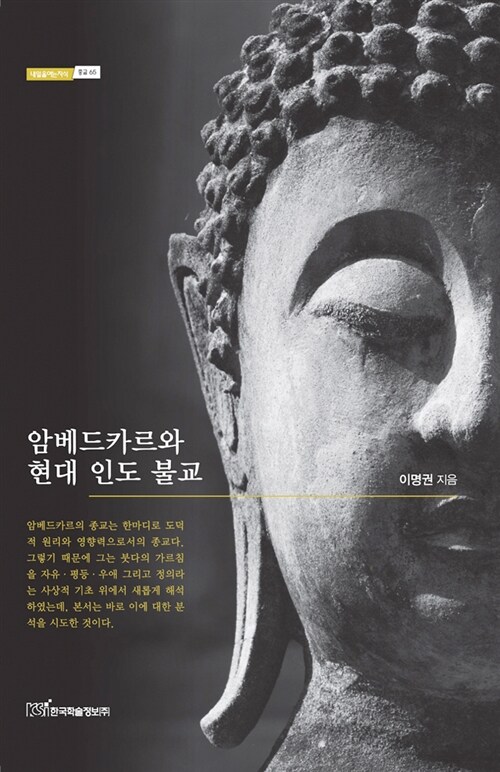

정가
25,000원
판매가
22,500원 (10%, 2,500원 할인)
전자책
15,000원

430쪽
책소개
'내일을 여는 지식 종교' 총서 65번째 책. 암베드카르의 종교는 한마디로 도덕적 원리와 영향력으로서의 종교다. 그렇기 때문에 그는 붓다의 가르침을 자유·평등·우애 그리고 정의라는 사상적 기초 위에서 새롭게 해석하였는데, 본서는 바로 이에 대한 분석을 시도한 것이다.
목차
머리말
I. 서 론
1. 우리는 왜 암베드카르를 주목해야 하는가?
2. 암베드카르의 발자취를 찾아서: 연구 범위와 방법론
3. 암베드카르에 대해 기존에는 어떤 연구가 있었는가?
Ⅱ. 현대 인도 불교 운동의 역사적 배경
1. 인도 불교의 발흥과 몰락
2. 신지학회(Theosophical Society, 神智學會)와 스리랑카 신불교(Protestant Buddhism)
3. 아나가리카 다르마팔라(Anag?rika Dharmap?la)와 마하보디협회
4. 다르마팔라 그 이후
Ⅲ. 암베드카르(B. R. Ambedkar)와 불가촉천민(不可觸賤民)
1. 암베드카르의 생애
2. 사회혁명: 불가촉천민(달리트, Dalit) 해방가로서의 암베드카르
Ⅳ. 암베드카르의 힌두교 포기와 불교 개종 배경
1 힌두교 포기와 ‘욜라 선언’
2. 타 종교에 대한 검토와 개종의 권유들
3. 불교 사상의 탐색과 개종 연설
Ⅴ. 암베드카르의 불교 사상
1. 사회적 가르침으로서의 종교: 합리적 믿음과 복지로서의 붓다의 가르침
2. 새로운 해석: 붓다와 그의 법
3. 내용과 구성
4. 암베드카르 불교 사상의 분석과 평가
Ⅵ. 맺는말: 암베드카르에 대한 평가와 현대 인도 불교의 전망
1. 암베드카르 이후의 사회적 유산(195 6년에서 2000년까지)
2. 암베드카르의 교훈
3. 암베드카르에 대한 평가
4. 암베드카르의 한계와 인도 불교의 미래
<부록> 현지 조사에 따른 분석: 2002년 이후
1. 현지조사의 한계점과 과제
2. 현지 조사 내용
3. 통계 분석으로 본 현지 조사 종합 분석
4. 맺는 말
참고 문헌
접기
저자 및 역자소개
이명권 (지은이)
저자파일
신간알리미 신청
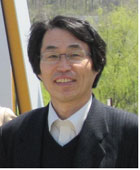
연세대학교신학과를 졸업하였고, 감리교 신학대학원 및 동국대학교 대학원 인도철학과에서 석사학위를 마쳤다. 서강대학교 대학원 종교학과에서 박사학위를 취득했고, 미국 <크리스천헤럴드> 편집장으로 활동했다. 관동대학교에서 ‘종교간의 대화’를 강의하였고, 그 후 중국 길림사범대학교에서 중국문학 석사학위를 취득한 후, 길림대학 중국철학과에서 노자 연구로 박사학위를 받았다. 중국 길림사범대학교에서 교환교수로 재직하였고, 동 대학 동아시아연구소 소장을 역임하였다. 그 후 서울신학대학교에서 초빙교수로 동양철학을 강의하였다. 현재 코리안아쉬람... 더보기
최근작 : <무함마드와 예수 그리고 이슬람>,<상호문화적 글로벌시대의 종교와 생태>,<상호문화적 글로벌시대의 종교와 정치> … 총 30종 (모두보기)
=======
출판사 제공 책소개
암베드카르는 인도 사회의 신분차별 제도가 힌두교라는 잘못된 전통 종교에서 기인한다고 보고, 힌두교의 이념을 거부하면서, 만인 평등의 기초가 되는 불교를 다시 받아들임으로써 현대 인도에 새로운 불교 운동을 일으켰다. 그러나 그가 주장한 불교는 전통적인 교리를 되풀이하는 관념적 불교가 아니라, 가난하고 억압받는 천민들을 해방시키는 실천적 해방의 불교였다.
암베드카르의 종교는 한마디로 도덕적 원리와 영향력으로서의 종교다. 그렇기 때문에 그는 붓다의 가르침을 자유·평등·우애 그리고 정의라는 사상적 기초 위에서 새롭게 해석하였는데, 본서는 바로 이에 대한 분석을 시도한 것이다.
알라딘: 암베드카르 평전- 간디와 맞선 인도 민중의 대부 게일 옴베트 2005
암베드카르 평전 - 간디와 맞선 인도 민중의 대부
게일 옴베트 (지은이),이상수 (옮긴이)필맥2005-07-01
다음
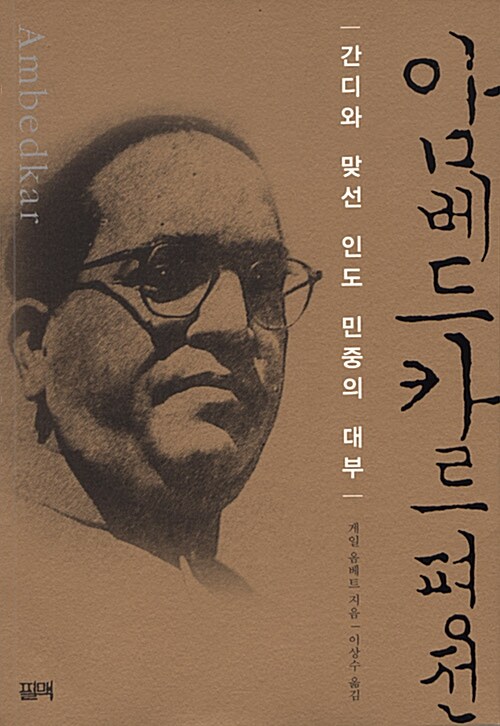


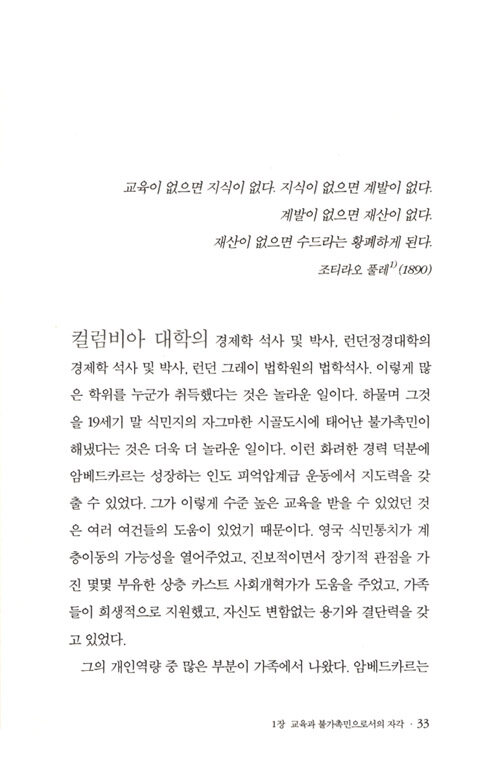

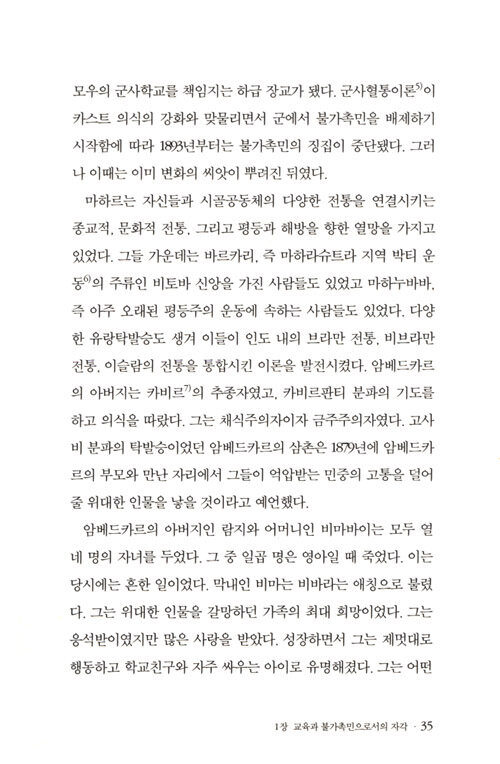
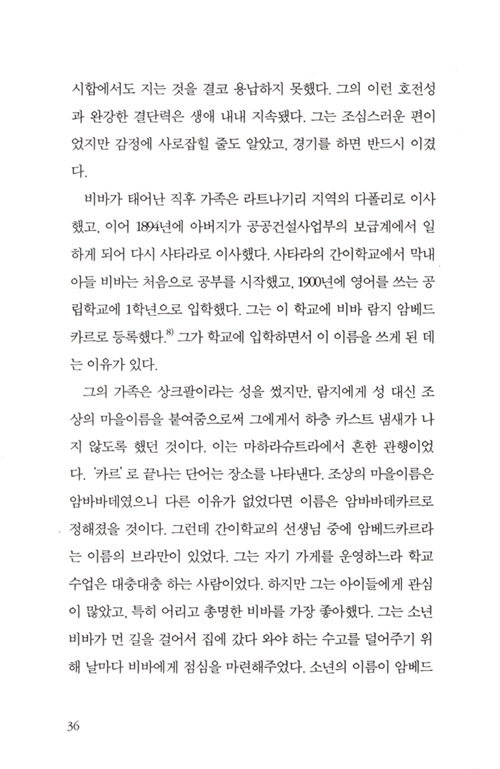
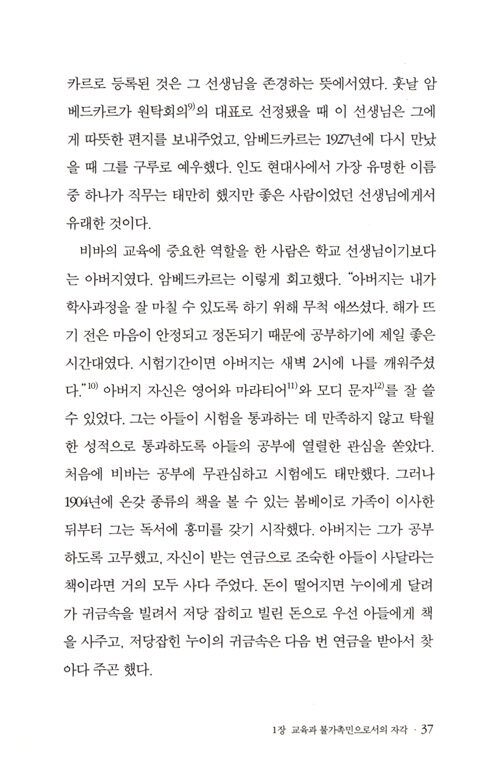
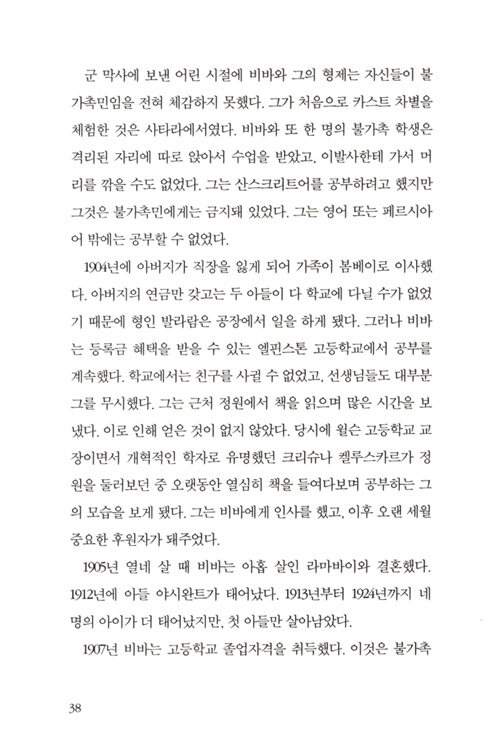
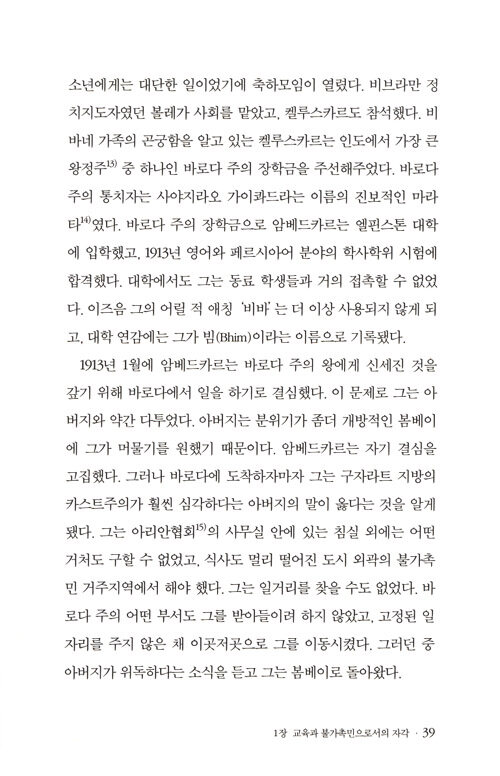

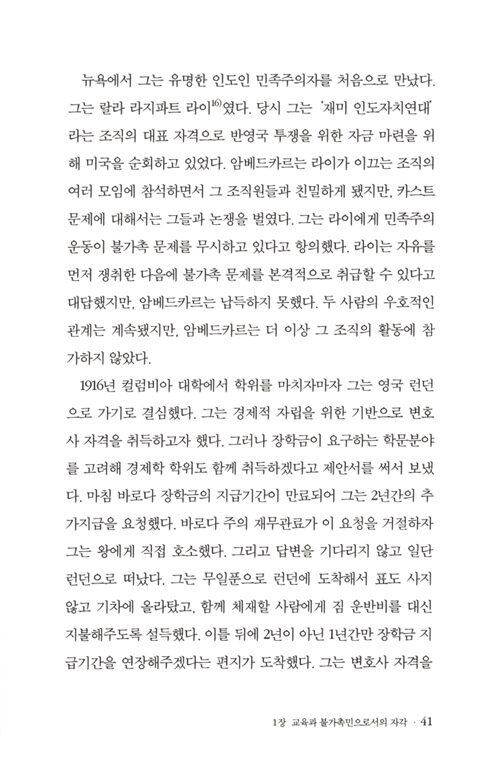
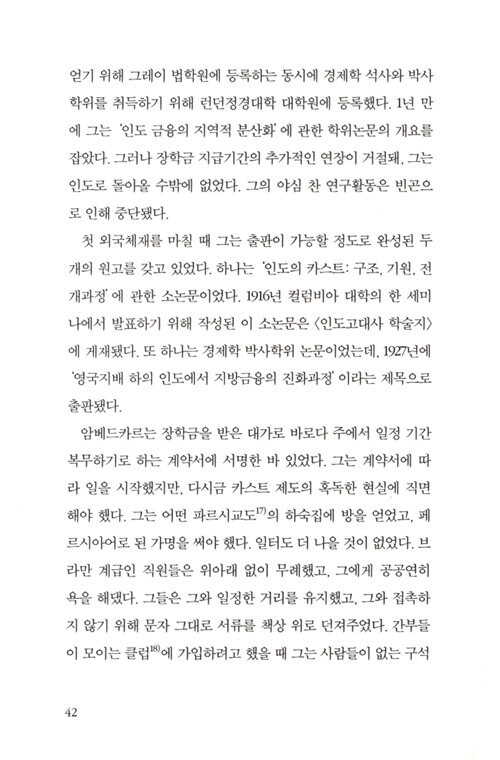
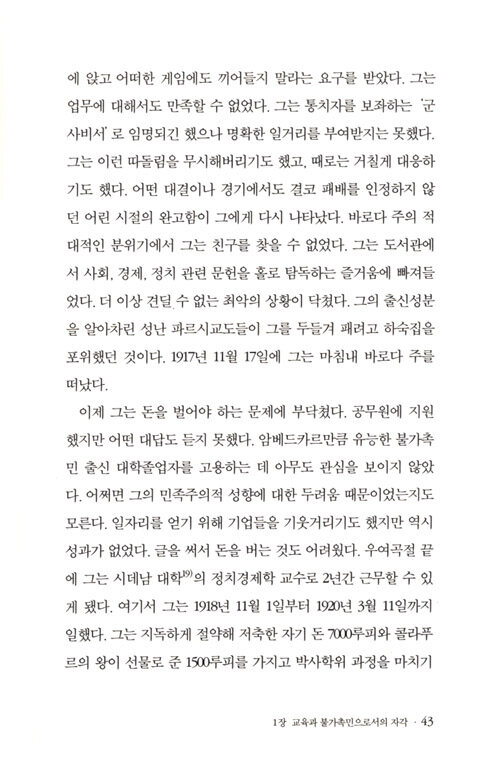


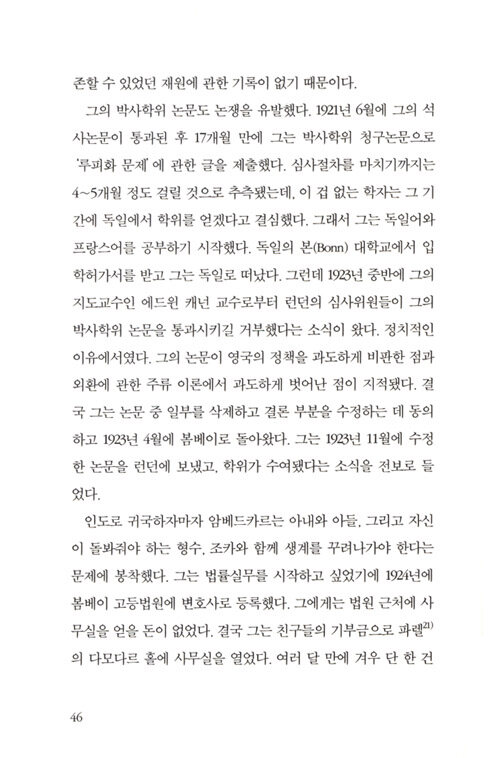

Sales Point : 521

이 책 어때요?
책소개
인도 사회의 최하층민인 불가촉민으로 태어나 불가촉민을 위해 평생을 바친 사회개혁가 암베드카르의 평전. 우리에게는 생고하지만 인도에서는 간디와 네루와 함께 널리 존경받는 인물, 암베드카르의 삶과 사상 그리고 당시 인도의 정치적 상황을 그린다.
암베드카르는 힌두교를 중심으로 인도의 통합을 꾀하던 간디를 비롯한 힌두 민족주의자들의 유화적 사회제도 개선책에 단호히 반대하고 불가촉민을 독자적인 정치세력으로 성장시켜 부당한 사회적 차별과 억압에서 벗어나게 하는 일에 최선을 다했던 인물.
암베드카르가 활동하던 독립 전후의 인도는 물론이고 현대의 인도를 이해하는 데도 도움을 준다. 옮긴이의 자세한 해설과 주석이 이해를 돕는다.
목차
옮긴이의 머리말
들어가는 글
1장 교육과 불가촉민으로서의 자각
"교육이 없으면 수드라는 황폐하게 된다"
2장 달리트의 인권을 위한 투쟁에 나서다
"우리는 브라만에 반대하는 게 아니라 브라만주의에 반대한다"
3장 민족주의자들의 양면성에 대한 대응
"간디 씨, 나는 조국이 없습니다"
4장 개종 문제 및 간디와의 대결
"나는 힌두교도로 죽지는 않을 것이다"
5장 계급적 급진주의의 시기
"인도 노동자들에게는 자본주의와 브라만주의라는 두 개의 적이 있다"
6장 전쟁과 평화, 그리고 파키스탄 문제
"우리는 하나의 국민이 될 수 있다. 다만…"
7장 독립 인도의 건설
"그는 마누의 법을 마하르의 법으로 바꾸었다"
8장 독립 이후의 시기
"똥 더미 위에 궁궐을 지으려는가"
9장 마지막 몇 년간
"종교가 필요하다면 그것은 부처의 종교일 수밖에 없다"
10장 암베드카르와 달리트의 자유투쟁
"그의 투쟁은 아직 끝나지 않았다"
옮긴이 후기
암베드카르 연보
주석
본문에 인용된 참고문헌
관련서적
접기
책속에서
1932년 이후 암베드카르는 간디를 결코 진정한 개혁가로 보지 않았다. 그 반대로 간디는 카스트 제도에 묶인 힌두교의 수호자이고, 시골마을을 미화하고, 근본적 변화 없이 약간 개칠된 기존 질서의 유지를 도모하는 낭만주의자라고 그는 생각했다.
1939년에 그는 '연방제와 자유'에 관한 강의에서 신랄한 평가를 내렸다. '내 생각에 간디의 시대는 인도의 암흑기임이 너무나 명백하다. 간디의 시대에는 사람들이 미래에서 이상을 찾지 않고 먼 옛날로 회귀한다.' - 본문 121~122쪽에서 접기
계속해서 그는 새로운 민주주의에서는 사회를 변화시키는 수단으로서 폭력과 사티아그라하는 폐기돼야 한다고 주장했다. 그리고 민주주의에 더욱 위험한 것은 전통적 스승인 '구루'를 신과 비슷한 존재로 떠받드는 인도인들의 경향이라고 주장했다.
'종교에서는 영웅숭배가 영혼을 구제하는 길인지 모르지만, 정치에서 영웅숭배는 확실한 타락의 길이고 결국은 독재로 이어지는 길'이라는 것이었다. - 본문 188쪽에서 접기
추천글
내가 치른 국장(國葬)
- 최성각 (작가, 풀꽃평화연구소장)
저자 및 역자소개
게일 옴베트 (Gail Omvedt) (지은이)
저자파일
신간알리미 신청
미국 미니애폴리스에서 태어났으나 인도 시민이 됐다. 버클리의 캘리포니아 대학에서 사회학으로 석사와 박사 학위를 취득했다. 1978년 이후 인도인인 남편 바라트 파탄카르와 함께 마하라슈트라 주 남부의 소도시인 카세가온에 정착해 살고 있다. 2005년 현재 사회운동 활동가이면서 뉴델리에 있는 네루 기념박물관 겸 도서관의 선임연구원이다.
인도에 관한 책을 많이 저술했다. 지은 책으로는 <인도의 불교 -브라만주의와 카스트에 대한 도전>(2003), <달리트의 전망>(1995), <달리트와 민주주의혁명>(1994), <혁명의 재창조 -인도의 신사회운동과 사회주의 전통>(1993), <식민지사회의 문화적 도전 -마하라슈트라의 비브라만 운동>(1966) 등이 있다. 최근에는 남편의 도움을 받아 마라티어 문헌을 영어로 번역하는 일을 하고 있다. 접기
최근작 : <암베드카르 평전> … 총 20종 (모두보기)
이상수 (옮긴이)
저자파일
신간알리미 신청
경북 의성에서 태어나 대구에서 초중고등학교를 마쳤다. 서울대학교 법과대학 졸업 후 최대권 교수의 지도 아래 같은 대학원에서 법사회학으로 석사 및 박사 학위를 받았다. 1997년부터 한남대학교에서 교수 생활을 시작했고, 2007년 서강대학교 법학전문대학원으로 옮겨 와 「법조윤리」, 「기업과 인권」, 「법사회학」, 「국제인권법」(일반대학원) 등의 강의를 맡아 지금까지 재직하고 있다. 2003년 인도 방갈로르의 ‘인도 국립로스쿨’에서 방문교수로 1년간 활동했으며, 2015년 프랑스 ‘파리 제1대학’(소르본 대학)에서도 방문교수로서 연구와 강의를 했다.
‘기업과 인권’(혹은 인권경영)에 관심을 가지고 연구를 시작한 것이 대략 2010년경부터이니, 이제 이 주제만으로도 10여 년의 연구 경력이 쌓인 셈인데, 그동안 매년 두 편 정도의 관련 논문을 꾸준히 발표했다. 물론 논문만 쓴 것은 아니었다. 법학연구소를 이끄는 동안에는 이 주제로 매년 대형 국제학술대회를 조직했다. 특히, 글로벌에서도 흔치 않은 「기업과 인권」이라는 과목을 법학전문대학원에 개설, 강의하여 현재 저자의 지도 아래 관련 학위논문을 준비하는 대학원생이 거의 열 명에 이르고 있는데, 이는 가장 큰 성과라 할 수 있다. 그 밖에 공익적 활동으로 국가인권위원회 및 법무부의 인권경영 관련 정책 자문에 수없이 응했고, 다수의 정책 과제를 직접 주도하거나 참여했으며, 공공기관의 인권경영위원을 맡거나 인권영향평가에 참여하기도 했다.
인권경영 현장 활동으로는, ‘밀양 송전선 분쟁’을 둘러싼 공익소송에 서강대 로스쿨 학생들과 함께 참여한 것, 그리고 현대중공업 사내하청노동자의 산업재해 관련 공익소송에 처음부터 끝까지 참여하여 결국은 승소하는 데 일조한 것을 꼽을 수 있다. 한편, 전국의 공공기관, 대학교, 시민단체, 로펌 등을 대상으로 한 인권경영 특강을 60여 차례나 함으로써 우리 사회의 인권경영 확산을 위해 노력해 왔다. 이 책은 이 모든 연구 및 대외 활동의 총결산이다.
인권경영 이외의 분야에서도 많은 활동을 했다. 서강대로 이직하기 직전 3년 정도는 로스쿨 도입 운동을 포함한 사법개혁 운동에 힘썼고, 2017년에는 법사회학회 회장을 맡아 2년간 학회를 이끌었다. 정부와도 깊이 연결되어 활동했는데, 특별히 많이 교류한 국가인권위원회뿐만 아니라, 대법원(양형위원회), 법무부(인권정책자문위원, 변호사징계위원회), 외무부, 검찰청(검찰시민위원회), 노동위원회(대전충남), 법조윤리협의회 등에서도 자문 등의 공익 활동을 했다. 그 밖에 전국의 중고등학생을 위한 진로특강도 20여 차례나 했다.
저서로 『법조윤리의 이론과 실제』(서강대학교 출판부, 2009), 『법사회학』(공저, 다산출판사, 2013), 『교양법학강의』(필맥, 2017), 『법조윤리』(공저, 박영사, 2022)가 있고, 번역서로 『암베드카르 평전』(게일 옴베트, 필맥, 2005), 『기업과 인권』(존 러기, 필맥, 2014)이 있다. 접기
최근작 : <법조윤리>,<인권경영, 세상을 바꾸는 패러다임>,<교양법학 강의> … 총 11종 (모두보기)
암베드카르는 간디를 이해하지 못했을 것
“우리가 고양이나 개만도 못한 취급을 받고 있고
먹을 물을 구할 수도 없는데,
어떻게 내가 이 땅을 나의 조국이라고 부르고
이 종교를 나의 종교라고 부를 수 있겠습니까?”
1. 서평
간디와 싸운 혁명가. 책을 읽고 난 뒤 가장 기억에 남는 부분이다. 책 제목에 ‘평전’이라는 말이 붙어 있는 것에서도 알 수 있듯이, 이 책은 암베드카르라는, 약간은 생소한 이름을 가진 사람의 일대기이다.
간디가 힌두교라는 큰 정신적 틀 안에서의 인도인들의 독립을 추구했다면, 암베드카르는 불가촉천민의 입장에서 인도에 새로운 질서를 추구했다. 불가촉천민은 인도의 카스트 제도 안에서 가장 낮은 지위를 가지고 있던 이들로, 말 그대로 만지는 것 자체가 불결해지는 사람들이다. 암베드카르는 불가촉천민으로 태어나 성장과정에서 여러 멸시와 고생을 하면서 자신과 같은 불가촉천민들을 해방하고자 평생을 바쳤던 인물이다.
일견 굉장히 과격한 투쟁을 전개했을 것 같지만, 사실은 그렇지 않았다. 암베드카르는 적극적인 입법투쟁을 통해, 또 그 자신이 국회의원으로, 정당 활동을 통해 불가촉천민들을 엄격한 신분적 제한에서 벗어나도록 했다. 하지만 간디를 중심으로 하는 강력한 국민회의 측의 반발, 기득권자들의 적대활동으로 사실상 그의 투쟁은 목적을 이루지 못했다. 제한적으로 제제의 완화는 있었지만(공동우물의 물을 마실 수 있다던가, 저수지를 이용할 수 있다던가 하는) 근본적인 해결책은 나오지 못했다. 여전히 불가촉천민이 만든 학교 급식을 먹지 않겠다고 반발을 하는 인도인 학생들이 있다는 뉴스가 해외토픽에 올라오는 것이 현실이다.
독립 후 인도의 초대 법무장관으로 재직하면서 인도 헌법의 기초를 놓기는 했으나, 그 때는 그의 투쟁력이 이미 약해질 대로 약해진 후였다. 오죽하면 늘 부딪혀왔던 간디의 국민회의 측의 지원으로 국회의원 의석을 차지하고, 법무장관이 되었을까. 정적들은 그가 더 이상 힘을 발휘할 수 없을 때에야 그에게 ‘자리’를 주었다. 개혁의 좌절.
그럼에도 불구하고 암베드카르는 여전히 마하르들의 정신적인 지도자로 남아 있다. 열성적인 운동가, 정치가, 행정가, 종교지도자. 불가촉천민이라는 열악한 상황에서도 유럽 등지에서 몇 개의 학위를 따 냈고, 복잡한 문제들에 직면해 있으면서도 끊임없이 학술적인 연구를 통해 논문을 발표했던 학구열에는 감탄을 할 수밖에 없다.
다만 자연과학적 세계관을 가지고 있었기에, 지나치게 영적인 부분을 가볍게 다루는 그의 태도는 주의해야 할 것이다. 마치 기독교를 합리주의적으로 설명하려고 시도했던 구(舊) 자유주의자들의 시도를 보는 듯 했다. 이런 점이 그의 또 다른 한계가 아니었을까? 암베드카르는 간디를 이해할 수 없었던 것이다.
2. 종합평가
인도의 또다른 영혼
힌두교를 중심으로 인도 민족의 단결과 독립을 주장한 간디와 달리 암베드카르는 계급적 억압을 구조 짖는 힌두교를 비판하면서 불가촉천민의 단결을 주장했습니다. 철저히 소외계급에 기초해서 사회를 변혁하려 했던 그는 현실 정치 속에서 사회주의에서 사민주의로, 사민주의에서 불교로 사상적 변화를 이어갑니다. 암베드카르의 정치적 행보에 집중하다보니 사상적 깊이나 얇아졌고, 거대한 인도가 너무 작은 신생 독립국처럼 그려진 것이 많이 아쉬웠습니다.
바람소리 2010-05-31 공감(0) 댓글(0)
T
B. R. Ambedkar - Wikipedia
B. R. Ambedkar
B. R. Ambedkar | |||
|---|---|---|---|
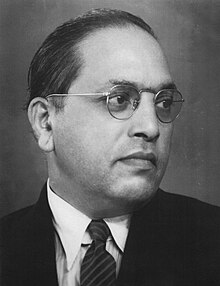 Ambedkar in the 1950s | |||
| Member of Parliament of Rajya Sabha for Bombay State | |||
| In office 3 April 1952 – 6 December 1956 | |||
| President | Rajendra Prasad | ||
| Prime Minister | Jawaharlal Nehru | ||
| 1st Minister of Law and Justice | |||
| In office 15 August 1947 – 6 October 1951 | |||
| President | Rajendra Prasad | ||
| Governors General | Louis Mountbatten C. Rajagopalachari | ||
| Prime Minister | Jawaharlal Nehru | ||
| Preceded by | Position established | ||
| Succeeded by | Charu Chandra Biswas | ||
| Chairman of the Constitution Drafting Committee | |||
| In office 29 August 1947 – 24 January 1950 | |||
| Member of the Constituent Assembly of India | |||
| In office 9 December 1946 – 24 January 1950 | |||
| Constituency | • Bengal Province (1946–47) • Bombay Province (1947–50) | ||
| Minister of Labour in Viceroy's Executive Council | |||
| In office 22 July 1942 – 20 October 1946 | |||
| Governors General | The Marquess of Linlithgow The Viscount Wavell | ||
| Preceded by | Feroz Khan Noon | ||
| |||
| Personal details | |||
| Pronunciation | Bhīmrāo Rāmjī Āmbēḍkar | ||
| Born | Bhiva Ramji Sakpal 14 April 1891 Mhow, Central India Agency, British India (now Madhya Pradesh, India) | ||
| Died | 6 December 1956 (aged 65) New Delhi, India[1][2] | ||
| Resting place | Chaitya Bhoomi 19°01′30″N 72°50′02″E 19°01′30″N 72°50′02″E | ||
| Political party | Independent Labour Party Scheduled Castes Federation | ||
| Other political affiliations | Republican Party of India | ||
| Spouses |
| ||
| Children | Yashwant | ||
| Relatives | Ambedkar family | ||
| Education | University of Mumbai (BA, MA) Columbia University (MA, PhD) London School of Economics (MSc, DSc) Gray's Inn | ||
| Profession |
| ||
| Awards | Bharat Ratna (1990, posthumous) | ||
| Signature |  | ||
| Nickname | Babasaheb | ||
Bhimrao Ramji Ambedkar (14 April 1891 – 6 December 1956) was an Indian jurist, economist, social reformer and political leader who headed the committee drafting the Constitution of India from the Constituent Assembly debates, served as Law and Justice minister in the first cabinet of Jawaharlal Nehru, and inspired the Dalit Buddhist movement after renouncing Hinduism.
After graduating from Elphinstone College, University of Bombay, Ambedkar studied economics at Columbia University and the London School of Economics, receiving doctorates in 1927 and 1923, respectively, and was among a handful of Indian students to have done so at either institution in the 1920s.[3] He also trained in the law at Gray's Inn, London. In his early career, he was an economist, professor, and lawyer. His later life was marked by his political activities; he became involved in campaigning and negotiations for partition, publishing journals, advocating political rights and social freedom for Dalits, and contributing to the establishment of the state of India. In 1956, he converted to Buddhism, initiating mass conversions of Dalits.[4]
In 1990, the Bharat Ratna, India's highest civilian award, was posthumously conferred on Ambedkar. The salutation Jai Bhim (lit. "Hail Bhim") used by followers honours him. He is also referred to by the nickname Babasaheb (BAH-bə SAH-hayb), meaning "Respected Father".
Early life
Ambedkar was born on 14 April 1891 in the town and military cantonment of Mhow (now officially known as Dr Ambedkar Nagar) (now in Madhya Pradesh).[5] He was the 14th and last child of Ramji Maloji Sakpal, an army officer who held the rank of Subedar, and Bhimabai Sakpal, daughter of Laxman Murbadkar.[6] His family was of Marathi background from the town of Ambadawe (Mandangad taluka) in Ratnagiri district of modern-day Maharashtra. Ambedkar was born into a Mahar (dalit) caste, who were treated as untouchables and subjected to socio-economic discrimination.[7] Ambedkar's ancestors had long worked for the army of the British East India Company, and his father served in the British Indian Army at the Mhow cantonment.[8] Although they attended school, Ambedkar and other untouchable children were segregated and given little attention or help by teachers. They were not allowed to sit inside the class. When they needed to drink water, someone from a higher caste had to pour that water from a height as they were not allowed to touch either the water or the vessel that contained it. This task was usually performed for the young Ambedkar by the school peon, and if the peon was not available then he had to go without water; he described the situation later in his writings as "No peon, No Water".[9] He was required to sit on a gunny sack which he had to take home with him.[10]
Ramji Sakpal retired in 1894 and the family moved to Satara two years later. Shortly after their move, Ambedkar's mother died. The children were cared for by their paternal aunt and lived in difficult circumstances. Three sons – Balaram, Anandrao and Bhimrao – and two daughters – Manjula and Tulasa – of the Ambedkars survived them. Of his brothers and sisters, only Ambedkar passed his examinations and went to high school. His original surname was Sakpal but his father registered his name as Ambadawekar in school, meaning he comes from his native village 'Ambadawe' in Ratnagiri district.[11][12][13][14] His Marathi Brahmin teacher, Krishnaji Keshav Ambedkar, changed his surname from 'Ambadawekar' to his own surname 'Ambedkar' in school records.[15][16][17][18][19]
Education
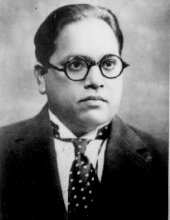
In 1897, Ambedkar's family moved to Mumbai where Ambedkar became the only untouchable enrolled at Elphinstone High School. In 1906, when he was about 15 years old, he married a nine-year-old girl, Ramabai. The match was arranged by the couple's parents, in accordance with prevailing custom at that time.[20]
In 1907, he passed his matriculation examination and in the following year he entered Elphinstone College, which was affiliated to the University of Bombay, becoming, according to him, the first from his Mahar caste to do so. When he passed his English fourth standard examinations, the people of his community wanted to celebrate because they considered that he had reached "great heights" which he says was "hardly an occasion compared to the state of education in other communities". A public ceremony was evoked, to celebrate his success, by the community, and it was at this occasion that he was presented with a biography of the Buddha by Dada Keluskar, the author and a family friend.[21]
By 1912, he obtained his degree in economics and political science from Bombay University, and prepared to take up employment with the Baroda state government. His wife had just moved his young family and started work when he had to quickly return to Mumbai to see his ailing father, who died on 2 February 1913.[22]

In 1913, at the age of 22, Ambedkar was awarded a Baroda State Scholarship of £11.50 (Sterling) per month for three years under a scheme established by Sayajirao Gaekwad III (Gaekwad of Baroda) that was designed to provide opportunities for postgraduate education at Columbia University in New York City. Soon after arriving there he settled in rooms at Livingston Hall with Naval Bhathena, a Parsi who was to be a lifelong friend. He passed his M.A. exam in June 1915, majoring in economics, and other subjects of Sociology, History, Philosophy and Anthropology. He presented a thesis, Ancient Indian Commerce. Ambedkar was influenced by John Dewey and his work on democracy.[23] In 1916, he completed his second master's thesis, National Dividend of India – A Historic and Analytical Study, for a second M.A.[24] On 9 May, he presented the paper Castes in India: Their Mechanism, Genesis and Development before a seminar conducted by the anthropologist Alexander Goldenweiser. Ambedkar received his Ph.D. degree in economics at Columbia in 1927.[3]

In October 1916, he enrolled for the Bar course at Gray's Inn, and at the same time enrolled at the London School of Economics where he started working on a doctoral thesis. In June 1917, he returned to India because his scholarship from Baroda ended. His book collection was dispatched on a different ship from the one he was on, and that ship was torpedoed and sunk by a German submarine.[22] He got permission to return to London to submit his thesis within four years. He returned at the first opportunity, and completed a master's degree in 1921. His thesis was on "The problem of the rupee: Its origin and its solution".[25] In 1923, he completed a D.Sc. in Economics which was awarded from University of London, and the same year he was called to the Bar by Gray's Inn.[3]
Opposition to untouchability
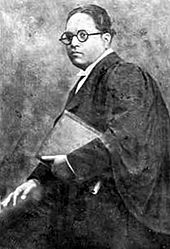
As Ambedkar was educated by the Princely State of Baroda, he was bound to serve it. He was appointed Military Secretary to the Gaikwad but had to quit in a short time. He described the incident in his autobiography, Waiting for a Visa.[26] Thereafter, he tried to find ways to make a living for his growing family. He worked as a private tutor, as an accountant, and established an investment consulting business, but it failed when his clients learned that he was an untouchable.[27] In 1918, he became professor of political economy in the Sydenham College of Commerce and Economics in Mumbai. Although he was successful with the students, other professors objected to his sharing a drinking-water jug with them.[28]
Ambedkar had been invited to testify before the Southborough Committee, which was preparing the Government of India Act 1919. At this hearing, Ambedkar argued for creating separate electorates and reservations for untouchables and other religious communities.[29] In 1920, he began the publication of the weekly Mooknayak (Leader of the Silent) in Mumbai with the help of Shahu of Kolhapur, that is, Shahu IV (1874–1922).[30]
Ambedkar went on to work as a legal professional. In 1926, he successfully defended three non-Brahmin leaders who had accused the Brahmin community of ruining India and were then subsequently sued for libel. Dhananjay Keer notes, "The victory was resounding, both socially and individually, for the clients and the doctor".[31]

While practising law in the Bombay High Court, he tried to promote education to untouchables and uplift them. His first organised attempt was his establishment of the central institution Bahishkrit Hitakarini Sabha, intended to promote education and socio-economic improvement, as well as the welfare of "outcastes", at the time referred to as depressed classes.[32] For the defence of Dalit rights, he started many periodicals like Mook Nayak, Bahishkrit Bharat, and Equality Janta.[33]
He was appointed to the Bombay Presidency Committee to work with the all-European Simon Commission in 1925.[34] This commission had sparked great protests across India, and while its report was ignored by most Indians, Ambedkar himself wrote a separate set of recommendations for the future Constitution of India.[35]
By 1927, Ambedkar had decided to launch active movements against untouchability. He began with public movements and marches to open up public drinking water resources. He also began a struggle for the right to enter Hindu temples. He led a satyagraha in Mahad to fight for the right of the untouchable community to draw water from the main water tank of the town.[36] In a conference in late 1927, Ambedkar publicly condemned the classic Hindu text, the Manusmriti (Laws of Manu), for ideologically justifying caste discrimination and "untouchability", and he ceremonially burned copies of the ancient text. On 25 December 1927, he led thousands of followers to burn copies of Manusmriti.[37][38] Thus annually 25 December is celebrated as Manusmriti Dahan Din (Manusmriti Burning Day) by Ambedkarites and Dalits.[39][40]
In 1930, Ambedkar launched the Kalaram Temple movement after three months of preparation. About 15,000 volunteers assembled at Kalaram Temple satygraha making one of the greatest processions of Nashik. The procession was headed by a military band and a batch of scouts; women and men walked with discipline, order and determination to see the god for the first time. When they reached the gates, the gates were closed by Brahmin authorities.[41]
Poona Pact

In 1932, the British colonial government announced the formation of a separate electorate for "Depressed Classes" in the Communal Award. Mahatma Gandhi fiercely opposed a separate electorate for untouchables, saying he feared that such an arrangement would divide the Hindu community.[42][43][44] Gandhi protested by fasting while imprisoned in the Yerwada Central Jail of Poona. Following the fast, congressional politicians and activists such as Madan Mohan Malaviya and Palwankar Baloo organised joint meetings with Ambedkar and his supporters at Yerwada.[45] On 25 September 1932, the agreement, known as the Poona Pact was signed between Ambedkar (on behalf of the depressed classes among Hindus) and Madan Mohan Malaviya (on behalf of the other Hindus). The agreement gave reserved seats for the depressed classes in the Provisional legislatures within the general electorate. Due to the pact the depressed class received 148 seats in the legislature instead of the 71, as allocated in the Communal Award proposed earlier by the colonial government under Prime Minister Ramsay MacDonald. The text used the term "Depressed Classes" to denote Untouchables among Hindus who were later called Scheduled Castes and Scheduled Tribes under the India Act 1935, and the later Indian Constitution of 1950.[46] In the Poona Pact, a unified electorate was in principle formed, but primary and secondary elections allowed Untouchables in practice to choose their own candidates.[47]
Political career


In 1935, Ambedkar was appointed principal of the Government Law College, Bombay, a position he held for two years. He also served as the chairman of Governing body of Ramjas College, University of Delhi, after the death of its Founder Shri Rai Kedarnath.[48] Settling in Bombay (today called Mumbai), Ambedkar oversaw the construction of a house, and stocked his personal library with more than 50,000 books.[49] His wife Ramabai died after a long illness the same year. It had been her long-standing wish to go on a pilgrimage to Pandharpur, but Ambedkar had refused to let her go, telling her that he would create a new Pandharpur for her instead of Hinduism's Pandharpur which treated them as untouchables. At the Yeola Conversion Conference on 13 October in Nasik, Ambedkar announced his intention to convert to a different religion and exhorted his followers to leave Hinduism.[49] He would repeat his message at many public meetings across India.
In 1936, Ambedkar founded the Independent Labour Party, which contested the 1937 Bombay election to the Central Legislative Assembly for the 13 reserved and 4 general seats, and secured 11 and 3 seats respectively.[50]
Ambedkar published his book Annihilation of Caste on 15 May 1936.[51] It strongly criticised Hindu orthodox religious leaders and the caste system in general,[52] and included "a rebuke of Gandhi" on the subject.[53] Later, in a 1955 BBC interview, he accused Gandhi of writing in opposition of the caste system in English language papers while writing in support of it in Gujarati language papers.[54] In his writings, Ambedkar also accused Jawaharlal Nehru of being "conscious of the fact that he is a Brahmin".[55]
During this time, Ambedkar also fought against the khoti system prevalent in Konkan, where khots, or government revenue collectors, regularly exploited farmers and tenants. In 1937, Ambedkar tabled a bill in the Bombay Legislative Assembly aimed at abolishing the khoti system by creating a direct relationship between government and farmers.[56]
Ambedkar served on the Defence Advisory Committee[57] and the Viceroy's Executive Council as minister of labour.[57] Before the Day of Deliverance events, Ambedkar stated that he was interested in participating: "I read Mr. Jinnah's statement and I felt ashamed to have allowed him to steal a march over me and rob me of the language and the sentiment which I, more than Mr. Jinnah, was entitled to use." He went on to suggest that the communities he worked with were twenty times more oppressed by Congress policies than were Indian Muslims; he clarified that he was criticizing Congress, and not all Hindus.[58] Jinnah and Ambedkar jointly addressed the heavily attended Day of Deliverance event in Bhindi Bazaar, Bombay, where both expressed "fiery" criticisms of the Congress party, and according to one observer, suggested that Islam and Hinduism were irreconcilable.[58][59]
After the Lahore resolution (1940) of the Muslim League demanding Pakistan, Ambedkar wrote a 400-page tract titled Thoughts on Pakistan, which analysed the concept of "Pakistan" in all its aspects. Ambedkar argued that the Hindus should concede Pakistan to the Muslims. He proposed that the provincial boundaries of Punjab and Bengal should be redrawn to separate the Muslim and non-Muslim majority parts. He thought the Muslims could have no objection to redrawing provincial boundaries. If they did, they did not quite "understand the nature of their own demand". Scholar Venkat Dhulipala states that Thoughts on Pakistan "rocked Indian politics for a decade". It determined the course of dialogue between the Muslim League and the Indian National Congress, paving the way for the Partition of India.[60][61]
In his work Who Were the Shudras?, Ambedkar tried to explain the formation of untouchables. He saw Shudras and Ati Shudras who form the lowest caste in the ritual hierarchy of the caste system, as separate from Untouchables. Ambedkar oversaw the transformation of his political party into the Scheduled Castes Federation, although it performed poorly in the 1946 elections for Constituent Assembly of India. Later he was elected into the constituent assembly of Bengal where Muslim League was in power.[62]
Jagjivan Ram's wife Indrani Jagjivan Ram wrote in her memoir that Ambedkar persuaded her husband to ask Mahatma Gandhi for his inclusion in Nehru's cabinet in independent India. Initially, Jagjivan Ram consulted Vallabhbhai Patel before asking Gandhi to recommend Ambedkar to Nehru for inclusion in cabinet, adding that Ambedkar had "given up his antagonism to Congress and Gandhiji". Ambedkar was ultimately included as the law minister of India in the First Nehru ministry after Gandhi recommended his name to Nehru.[63][64]
Ambedkar contested in the Bombay North first Indian General Election of 1952, but lost to his former assistant and Congress Party candidate Narayan Kajrolkar. Ambedkar became a member of Rajya Sabha, probably an appointed member. He tried to enter Lok Sabha again in the by-election of 1954 from Bhandara, but he placed third (the Congress Party won). By the time of the second general election in 1957, Ambedkar had died.
Ambedkar also criticised Islamic practice in South Asia. While justifying the Partition of India, he condemned child marriage and the mistreatment of women in Muslim society.
No words can adequately express the great and many evils of polygamy and concubinage, and especially as a source of misery to a Muslim woman. Take the caste system. Everybody infers that Islam must be free from slavery and caste. [...] [While slavery existed], much of its support was derived from Islam and Islamic countries. While the prescriptions by the Prophet regarding the just and humane treatment of slaves contained in the Koran are praiseworthy, there is nothing whatever in Islam that lends support to the abolition of this curse. But if slavery has gone, caste among Musalmans [Muslims] has remained.[65]
Drafting of India's Constitution

Upon India's independence on 15 August 1947, the new prime minister Jawaharlal Nehru invited Ambedkar to serve as the Dominion of India's Law Minister; two weeks later, he was appointed Chairman of the Drafting Committee of the Constitution for the future Republic of India.
On 25 November 1949, Ambedkar in his concluding speech in constituent assembly said:[66]
"The credit that is given to me does not really belong to me. It belongs partly to Sir B.N. Rau the Constitutional Advisor to the Constituent Assembly who prepared a rough draft of the Constitution for the consideration of the Drafting Committee."
Indian constitution guarantees and protections for a wide range of civil liberties for individual citizens, including freedom of religion, the abolition of untouchability, and the outlawing of all forms of discrimination. Ambedkar was one of the ministers who argued for extensive economic and social rights for women, and won the Assembly's support for introducing a system of reservations of jobs in the civil services, schools and colleges for members of scheduled castes and scheduled tribes and Other Backward Class, a system akin to affirmative action. India's lawmakers hoped to eradicate the socio-economic inequalities and lack of opportunities for India's depressed classes through these measures.[67] The Constitution was adopted on 26 November 1949 by the Constituent Assembly.[68]
Ambedkar expressed his disapproval for the constitution in 1953 during a parliament session and said "People always keep on saying to me "Oh you are the maker of the constitution". My answer is I was a hack. What I was asked to do, I did much against my will." Ambedkar added that, "I am quite prepared to say that I shall be the first person to burn it out. I do not want it. It does not suit anybody."[69][70]
Economics
Ambedkar was the first Indian to pursue a doctorate in economics abroad.[71] He argued that industrialisation and agricultural growth could enhance the Indian economy.[72] He stressed investment in agriculture as the primary industry of India.[citation needed] Ambedkar advocated national economic and social development, stressing education, public hygiene, community health, residential facilities as the basic amenities.[72] His DSc thesis, The problem of the Rupee: Its Origin and Solution (1923) examines the causes for the Rupee's fall in value. In this dissertation, he argued in favour of a gold standard in modified form, and was opposed to the gold-exchange standard favoured by Keynes in his treatise Indian Currency and Finance (1909), claiming it was less stable. He favoured the stoppage of all further coinage of the rupee and the minting of a gold coin, which he believed would fix currency rates and prices.[73]
He also analysed revenue in his PhD dissertation The Evolution of Provincial Finance in British India. In this work, he analysed the various systems used by the British colonial government to manage finances in India.[73][74] His views on finance were that governments should ensure their expenditures have "faithfulness, wisdom and economy." "Faithfulness" meaning governments should use money as nearly as possible to the original intentions of spending the money in the first place. "Wisdom" meaning it should be used as well as possible for the public good, and "economy" meaning the funds should be used so that the maximum value can be extracted from them.[75]
Ambedkar opposed income tax for low-income groups. He contributed in Land Revenue Tax and excise duty policies to stabilise the economy.[citation needed] He played an important role in land reform and the state economic development.[citation needed] According to him, the caste system, due to its division of labourers and hierarchical nature, impedes movement of labour (higher castes would not do lower-caste occupations) and movement of capital (assuming investors would invest first in their own caste occupation). His theory of State Socialism had three points: state ownership of agricultural land, the maintenance of resources for production by the state, and a just distribution of these resources to the population. He emphasised a free economy with a stable Rupee which India has adopted recently.[citation needed] He advocated birth control to develop the Indian economy, and this has been adopted by Indian government as national policy for family planning. He emphasised equal rights for women for economic development.[citation needed]
A number of Ambedkar's ideas reflected deep interest in Austrian school of economics. The ideas of Ambedkar were close to those of Carl Menger, Ludwig von Mises, Friedrich Hayek, and William Graham Sumner. Ambedkar's theory of free banking was built on Menger's work and also on Gopal Krishna Gokhale's treatise on finance and money. Ambedkar's view about distinguishing differential quality of money was influenced by Menger's idea of sale-ability of money which is found in Menger's article 'On the Origin of Money'. Ambedkar's recommendations for free banking were ignored by both Royal Commission and Indian government.[76]
In his book, "The Evolution of Provincial Finance in British India", Ambedkar wrote "a Central Government for the whole of India could not be said to possess knowledge and experience of all various conditions prevailing in different Provinces under it. It, therefore, necessarily becomes an authority less competent to deal with matters of provincial administration than the Provisional Governments.'[76]
Ambedkar's views on agricultural land was that too much of it was idle, or that it was not being utilized properly. He believed there was an "ideal proportion" of production factors that would allow agricultural land to be used most productively. To this end, he saw the large portion of people who lived on agriculture at the time as a major problem. Therefore, he advocated industrialization of the economy to allow these agricultural labourers to be of more use elsewhere.[citation needed] Ambedkar was of the view that there is a need to shift surplus labour from agricultural channels to non-agricultural channels.[77]
Ambedkar was trained as an economist, and was a professional economist until 1921, when he became a political leader. He wrote three books on economics:
- Administration and Finance of the East India Company
- The Evolution of Provincial Finance in British India
- The Problem of the Rupee: Its Origin and Its Solution[78][79]
Marriage
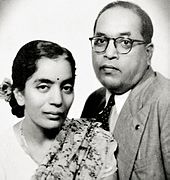
Ambedkar's first wife Ramabai died in 1935 after a long illness. After completing the draft of India's constitution in the late 1940s, he suffered from lack of sleep, had neuropathic pain in his legs, and was taking insulin and homoeopathic medicines. He went to Bombay for treatment, and there met Sharada Kabir, whom he married on 15 April 1948, at his home in New Delhi. Doctors recommended a companion who was a good cook and had medical knowledge to care for him.[80] She adopted the name Savita Ambedkar and cared for him the rest of his life.[81] Savita Ambedkar, who was called also 'Mai', died on May 29, 2003, aged 93 in Mumbai.[82]
Conversion to Buddhism
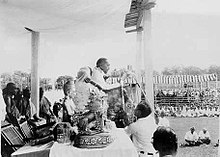
Ambedkar considered converting to Sikhism, which encouraged opposition to oppression and so appealed to leaders of scheduled castes. But after meeting with Sikh leaders, he concluded that he might get "second-rate" Sikh status.[83]
Instead, around 1950, he began devoting his attention to Buddhism and travelled to Ceylon (now Sri Lanka) to attend a meeting of the World Fellowship of Buddhists.[84] While dedicating a new Buddhist vihara near Pune, Ambedkar announced he was writing a book on Buddhism, and that when it was finished, he would formally convert to Buddhism.[85] He twice visited Burma in 1954; the second time to attend the third conference of the World Fellowship of Buddhists in Rangoon.[86] In 1955, he founded the Bharatiya Bauddha Mahasabha, or the Buddhist Society of India.[87] In 1956, he completed his final work, The Buddha and His Dhamma, which was published posthumously.[87]
After meetings with the Sri Lankan Buddhist monk Hammalawa Saddhatissa,[88] Ambedkar organised a formal public ceremony for himself and his supporters in Nagpur on 14 October 1956. Accepting the Three Refuges and Five Precepts from a Buddhist monk in the traditional manner, Ambedkar completed his own conversion, along with his wife. He then proceeded to convert some 500,000 of his supporters who were gathered around him.[85][89] He prescribed the 22 Vows for these converts, after the Three Jewels and Five Precepts. He then travelled to Kathmandu, Nepal to attend the Fourth World Buddhist Conference.[86] His work on The Buddha or Karl Marx and "Revolution and counter-revolution in ancient India" remained incomplete.
Death

Since 1948, Ambedkar had diabetes. He remained in bed from June to October in 1954 due to medication side-effects and poor eyesight.[85] His health worsened during 1955. Three days after completing his final manuscript The Buddha and His Dhamma, Ambedkar died in his sleep on 6 December 1956 at his home in Delhi.[90]
A Buddhist cremation was organised at Dadar Chowpatty beach on 7 December,[91] attended by half a million grieving people.[92] A conversion program was organised on 16 December 1956,[93] so that cremation attendees were also converted to Buddhism at the same place.[93]
Ambedkar was survived by his second wife Savita Ambedkar (known as Maisaheb Ambedkar), who died in 2003,[94] and his son Yashwant Ambedkar (known as Bhaiyasaheb Ambedkar), who died in 1977.[95] Savita and Yashwant carried on the socio-religious movement started by B. R. Ambedkar. Yashwant served as the 2nd President of the Buddhist Society of India (1957–1977) and a member of the Maharashtra Legislative Council (1960–1966).[96][97] Ambedkar's elder grandson, Prakash Yashwant Ambedkar, is the chief-adviser of the Buddhist Society of India,[98] leads the Vanchit Bahujan Aghadi[99][100] and has served in both houses of the Indian Parliament.[100] Ambedkar's younger grandson, Anandraj Ambedkar leads the Republican Sena (tran: The "Republican Army").[101]
A number of unfinished typescripts and handwritten drafts were found among Ambedkar's notes and papers and gradually made available. Among these were Waiting for a Visa, which probably dates from 1935 to 1936 and is an autobiographical work, and the Untouchables, or the Children of India's Ghetto, which refers to the census of 1951.[85]
A memorial for Ambedkar was established in his Delhi house at 26 Alipur Road. His birthdate known as Ambedkar Jayanti or Bhim Jayanti is observed as a public holiday in many Indian states. He was posthumously awarded India's highest civilian honour, the Bharat Ratna, in 1990.[102]
On the anniversary of his birth and death, and on Dhamma Chakra Pravartan Din (14 October) at Nagpur, at least half a million people gather to pay homage to him at his memorial in Mumbai.[103] Thousands of bookshops are set up, and books are sold. His message to his followers was "educate, agitate, organise!"[104]
Legacy


Ambedkar's legacy as a socio-political reformer had a deep effect on modern India.[105][106] In post-Independence India, his socio-political thought is respected across the political spectrum. His initiatives have influenced various spheres of life and transformed the way India today looks at socio-economic policies, education and affirmative action through socio-economic and legal incentives. His reputation as a scholar led to his appointment as free India's first law minister, and chairman of the committee for drafting the constitution. He passionately believed in individual freedom and criticised caste society. His accusations of Hinduism as being the foundation of the caste system made him controversial and unpopular among Hindus.[107] His conversion to Buddhism sparked a revival in interest in Buddhist philosophy in India and abroad.[108]
Many public institutions are named in his honour, and the Dr. Babasaheb Ambedkar International Airport in Nagpur, otherwise known as Sonegaon Airport. Dr. B. R. Ambedkar National Institute of Technology, Jalandhar, Ambedkar University Delhi is also named in his honour.[109]
The Maharashtra government has acquired a house in London where Ambedkar lived during his days as a student in the 1920s. The house is expected to be converted into a museum-cum-memorial to Ambedkar.[110]
Ambedkar was voted "the Greatest Indian" since independence by a poll organised by History TV18 and CNN IBN, ahead of Patel and Nehru, in 2012. Nearly 20 million votes were cast.[111] Due to his role in economics, Narendra Jadhav, a notable Indian economist,[112] has said that Ambedkar was "the highest educated Indian economist of all times."[113] Amartya Sen, said that Ambedkar is "father of my economics", and "he was highly controversial figure in his home country, though it was not the reality. His contribution in the field of economics is marvelous and will be remembered forever."[114][115]
On 2 April 1967, an 3.66 metre (12 foot) tall bronze statue of Ambedkar was installed in the Parliament of India. The statue, sculpted by B.V. Wagh, was unveiled by the then President of India, Sarvepalli Radhakrishnan.[116][117][118] On 12 April 1990, a portrait of B.R. Ambedkar is put in the Central Hall of Parliament House.[119][120][121] The portrait of Ambedkar, painted by Zeba Amrohawi, was unveiled by the then Prime Minister of India, V. P. Singh.[119] Another portrait of Ambedkar is put in the Parliamentary Museum and archives of the Parliament House.[122][123]
Ambedkar's legacy was not without criticism. Ambedkar has been criticised for his one-sided views on the issue of caste at the expense of cooperation with the larger nationalist movement.[124] Ambedkar has been also criticised by some of his biographers over his neglect of organization-building.[125]
Ambedkar's political philosophy has given rise to a large number of political parties, publications and workers' unions that remain active across India, especially in Maharashtra. His promotion of Buddhism has rejuvenated interest in Buddhist philosophy among sections of population in India. Mass conversion ceremonies have been organised by human rights activists in modern times, emulating Ambedkar's Nagpur ceremony of 1956.[126] Some Indian Buddhists regard him as a Bodhisattva, although he never claimed it himself.[127] Outside India, during the late 1990s, some Hungarian Romani people drew parallels between their own situation and that of the downtrodden people in India. Inspired by Ambedkar, they started to convert to Buddhism.[128]
The Ambedkar Statue in Hyderabad is a statue of B. R. Ambedkar located in Hyderabad. The statue was designed by Ram V. Sutar. The foundation stone was laid in 2016, but the construction of the statue began in 2021. The statue was inaugurated on 14 April 2023, by K. Chandrashekhar Rao, the Chief Minister of Telangana, on the 132nd Ambedkar Jayanti. Ambedkar's grandson Prakash Ambedkar was the chief guest of the event. The statue is made up of over 360 tonnes of steel and 100 tonnes of bronze.[129][130][131][132][133]
Views
Religion
Ambedkar said in 1935 that he was born a Hindu but would not die a Hindu. He viewed Hinduism as an "oppressive religion" and started to consider conversion to any other religion.[134] In Annihilation of Caste, Ambedkar claims that the only lasting way a true casteless society could be achieved is through destroying the belief of the sanctity of the Shastras and denying their authority.[135] Ambedkar was critical of Hindu religious texts and epics and wrote a work titled Riddles in Hinduism during 1954–1955. The work was published posthumously by combining individual chapter manuscripts and resulted in mass demonstrations and counter demonstrations.[136][137][138]
Ambedkar viewed Christianity to be incapable of fighting injustices. He wrote that "It is an incontrovertible fact that Christianity was not enough to end the slavery of the Negroes in the United States. A civil war was necessary to give the Negro the freedom which was denied to him by the Christians."[139]
Ambedkar criticized distinctions within Islam and described the religion as "a close corporation and the distinction that it makes between Muslims and non-Muslims is a very real, very positive and very alienating distinction".[140]
He opposed conversions of depressed classes to convert to Islam or Christianity added that if they converted to Islam then "the danger of Muslim domination also becomes real" and if they converted to Christianity then it "will help to strengthen the hold of Britain on the country".[141]
Initially, Ambedkar planned to convert to Sikhism but he rejected this idea after he discovered that British government would not guarantee the privileges accorded to the untouchables in reserved parliamentary seats.[142]
On 16 October 1956, he converted to Buddhism just weeks before his death.[143]
Aryan Invasion Theory
Ambedkar viewed the Shudras as Aryan and adamantly rejected the Aryan invasion theory, describing it as "so absurd that it ought to have been dead long ago" in his 1946 book Who Were the Shudras?.[144] Ambedkar viewed Shudras as originally being "part of the Kshatriya Varna in the Indo-Aryan society", but became socially degraded after they inflicted many tyrannies on Brahmins.[145]
According to Arvind Sharma, Ambedkar noticed certain flaws in the Aryan invasion theory that were later acknowledged by western scholarship. For example, scholars now acknowledge anās in Rig Veda 5.29.10 refers to speech rather than the shape of the nose.[146] Ambedkar anticipated this modern view by stating:
The term Anasa occurs in Rig Veda V.29.10. What does the word mean? There are two interpretations. One is by Prof. Max Muller. The other is by Sayanacharya. According to Prof. Max Muller, it means 'one without nose' or 'one with a flat nose' and has as such been relied upon as a piece of evidence in support of the view that the Aryans were a separate race from the Dasyus. Sayanacharya says that it means 'mouthless,' i.e., devoid of good speech. This difference of meaning is due to difference in the correct reading of the word Anasa. Sayanacharya reads it as an-asa while Prof. Max Muller reads it as a-nasa. As read by Prof. Max Muller, it means 'without nose.' Question is : which of the two readings is the correct one? There is no reason to hold that Sayana's reading is wrong. On the other hand there is everything to suggest that it is right. In the first place, it does not make non-sense of the word. Secondly, as there is no other place where the Dasyus are described as noseless, there is no reason why the word should be read in such a manner as to give it an altogether new sense. It is only fair to read it as a synonym of Mridhravak. There is therefore no evidence in support of the conclusion that the Dasyus belonged to a different race.[146]
Ambedkar disputed various hypotheses of the Aryan homeland being outside India, and concluded the Aryan homeland was India itself. According to Ambedkar, the Rig Veda says Aryans, Dāsa and Dasyus were competing religious groups, not different peoples.[147]
Communism
Ambedkar's views on Communism were expressed in two 1956 texts, "Buddha or Karl Marx" and "Buddhism and Communism".[148] He accepted the Marxist theory that the privileged few's exploitation of the masses perpetuated poverty and its issues. However, he did not see this exploitation as purely economic, theorizing that the cultural aspects of exploitation are as bad or worse than economic exploitation. In addition, he did not see economic relationships as the only important aspect of human life. He also saw Communists as willing to resort to any means to achieve proletarian revolution, including violence, while he himself saw democratic and peaceful measures as the best option for change. Ambedkar also opposed the Marxist idea of controlling all the means of production and ending private ownership of property: seeing the latter measure as not able to fix the problems of society. In addition, rather than advocating for the eventual annihilation of the state as Marxism does, Ambedkar believed in a classless society, but also believed the state would exist as long as society and that it should be active in development.[73] But in the 1950s, in an interview he gave to BBC, he accepted that the current liberal democratic system will collapse and the alternative, as he thinks, "is some kind of communism".[149]
In popular culture
Several films, plays, and other works have been based on the life and thoughts of Ambedkar.
- Indian director Jabbar Patel made a documentary titled Dr. Babasaheb Ambedkar in 1991; he followed this with a full-length feature film Dr. Babasaheb Ambedkar in 2000 with Mammootty in the lead role.[150] This biopic was sponsored by the National Film Development Corporation of India and the government's Ministry of Social Justice and Empowerment. The film was released after a long and controversial gestation.[151]
- Other Indian films on Ambedkar include: Balaka Ambedkar (1991) by Basavaraj Kestur, Dr. Ambedkar (1992) by Bharath Parepalli, and Yugpurush Dr. Babasaheb Ambedkar (1993).
- David Blundell, professor of anthropology at UCLA and historical ethnographer, has established Arising Light – a series of films and events that are intended to stimulate interest and knowledge about the social conditions in India and the life of Ambedkar.[152] In Samvidhaan,[153] a TV mini-series on the making of the Constitution of India directed by Shyam Benegal, the pivotal role of B. R. Ambedkar was played by Sachin Khedekar. The play Ambedkar Aur Gandhi, directed by Arvind Gaur and written by Rajesh Kumar, tracks the two prominent personalities of its title.[154]
- Bhimayana: Experiences of Untouchability is a graphic biography of Ambedkar created by Pardhan-Gond artists Durgabai Vyam and Subhash Vyam, and writers Srividya Natarajan and S. Anand. The book depicts the experiences of untouchability faced by Ambedkar from childhood to adulthood. CNN named it one of the top 5 political comic books.[155]
- The Ambedkar Memorial at Lucknow is dedicated in his memory. The chaitya consists of monuments showing his biography.[156][157]
- Jai Bhim slogan was given by the Dalit community in Delhi in his honour in 1946.[158]
- Google commemorated Ambedkar's 124th birthday through a homepage doodle on 14 April 2015.[159][160] The doodle was featured in India, Argentina, Chile, Ireland, Peru, Poland, Sweden and the United Kingdom.[161][162][163]
- An Indian television show named Ek Mahanayak: Dr. B. R. Ambedkar portraying his life aired on &TV in 2019.[164]
- Another show, Dr. Babasaheb Ambedkar - Mahamanvachi Gauravgatha, has aired in Marathi on Star Pravah from 2019.[165]
Works
The Education Department, Government of Maharashtra (Mumbai) published the collection of Ambedkar's writings and speeches in different volumes.[166] The list of Ambedkar's works include the following:
- Castes in India: Their Mechanism, Genesis and Development and 11 Other Essays
- The Annihilation of Caste, (1936)
- Ambedkar in the Bombay Legislature, with the Simon Commission and at the Round Table Conferences, (1927–1939)
- Philosophy of Hinduism; India and the Pre-requisites of Communism; Revolution and Counter-revolution; Buddha or Karl Marx
- Riddles in Hinduism [167]
- Essays on Untouchables and Untouchability
- The Evolution of Provincial Finance in British India
- The Untouchables Who Were They And Why They Became Untouchables ?
- Who Were the Shudras? (1946)
- Pakistan or The Partition of India (1945),[168] also published as Thoughts on Pakistan (1941)[169]
- What Congress and Gandhi have done to the Untouchables; Mr. Gandhi and the Emancipation of the Untouchables
- Ambedkar as member of the Governor General's Executive Council, 1942–46
- The Buddha and his Dhamma
- Unpublished Writings; Ancient Indian Commerce; Notes on laws; Waiting for a Visa ; Miscellaneous notes, etc.
- Ambedkar as the principal architect of the Constitution of India
- (2 parts) Dr. Ambedkar and The Hindu Code Bill
- Ambedkar as Free India's First Law Minister and Member of Opposition in Indian Parliament (1947–1956)
- The Pali Dictionary and The Pali Grammar[170]
- Ambedkar and his Egalitarian Revolution – Struggle for Human Rights. Events starting from March 1927 to 17 November 1956 in the chronological order;
- Ambedkar and his Egalitarian Revolution – Socio-political and religious activities. Events starting from November 1929 to 8 May 1956 in the chronological order;
- Ambedkar and his Egalitarian Revolution – Speeches. (Events starting from 1 January to 20 November 1956 in the chronological order.)
See also
References
- ^ Sengupta, Debjani (26 August 2019). "An Informal Guide to the Ambedkar National Memorial in Delhi". TheWire.in. The Wire. Retrieved 20 August 2021.
- ^ "The official Website of Dr. Ambedkar International Center- DAIC". Archived from the original on 14 April 2021.
- ^ Jump up to:a b c Krishnamurty, J. (2020), "Ambedkar's Educational Odyssey, 1913–1927", Journal of Social Inclusion Studies, SAGE, 5 (2): 1–11, doi:10.1177/2394481119900074, S2CID 212824611,
(p. 2) Ambedkar obtained his London DSc degree in 1923 for his thesis 'Problem of the Rupee' (University of London, 1926). However, he was not the first Indian to achieve this feat. Records of the London University clearly show that John Matthai and Pramathanath Bandyopadhyay (more popularly known as Pramathanath Banerjea) obtained their DSc degrees from the university in 1916. ... (p. 3) Turning to US doctorates, while Ambedkar was one of the early Indians to work for a PhD in the USA, he was awarded his degree by Columbia University only in 1927. The first Indian PhD in Economics in the USA was probably Rajani Kanta Das, a labour economist, who worked with Professor John Commons and was awarded the PhD degree by the University of Wisconsin in 1917.
- ^ Buswell, Robert Jr; Lopez, Donald S. Jr., eds. (2013). Princeton Dictionary of Buddhism. Princeton, NJ: Princeton University Press. p. 34. ISBN 978-0691157863.
- ^ Jaffrelot, Christophe (2005). Ambedkar and Untouchability: Fighting the Indian Caste System. New York: Columbia University Press. p. 2. ISBN 0-231-13602-1.
- ^ Pritchett, Frances. "In the 1890s" (PHP). Archived from the original on 7 September 2006. Retrieved 2 August 2006.
- ^ "Mahar". Encyclopædia Britannica. britannica.com. Archived from the original on 30 November 2011. Retrieved 12 January 2012.
- ^ Ahuja, M. L. (2007). "Babasaheb Ambedkar". Eminent Indians: administrators and political thinkers. New Delhi: Rupa. pp. 1922–1923. ISBN 978-8129111074. Archived from the original on 23 December 2016. Retrieved 17 July 2013.
- ^ Ambedkar, B. R. "Waiting for a Visa". Frances Pritchett, translator. Columbia.edu. Archived from the original on 24 June 2010. Retrieved 17 July 2010.
- ^ Kurian, Sangeeth (23 February 2007). "Human rights education in schools". The Hindu. Archived from the original on 3 November 2013.
- ^ "आंबडवे नाव योग्यच – खासदार अमर साबळे". 14 April 2016. Retrieved 20 August 2021.
- ^ "डॉ. बाबासाहेब आंबेडकर यांचे मूळ गाव आंबवडे येथे आंतरराष्ट्रीय दर्जाचे शैक्षणिक संकुल". 18 April 2014. Retrieved 20 August 2021.
- ^ "आंबेडकर गुरुजींचं कुटुंब जपतंय सामाजिक वसा, कुटुंबानं सांभाळल्या 'त्या' आठवणी".[permanent dead link]
- ^ "Bhim, Eklavya". outlookindia.com. Archived from the original on 11 August 2010. Retrieved 17 July 2010.
- ^ "आपने देखा आंबेडकर का जर्जर होता स्कूल?". BBC.com. BBC Hindi. 7 November 2017. Retrieved 20 August 2021.
- ^ Adshul, Ashok (26 December 2016). "आंबेडकर गुरुजींचं कुटुंब जपतंय सामाजिक वसा, कुटुंबानं सांभाळल्या 'त्या' आठवणी". Divyamarathi.com. Divya Marathi. Archived from the original on 28 May 2019. Retrieved 20 August 2021.
- ^ Prasad, Kamta (4 July 2020). "डॉ. भीम राव आम्बेडकर को उनके गुरु कृष्ण केशव आम्बेडकर ने दिया था अपना सरनेम". LiveHindustan.com. Live Hindustan. Retrieved 20 August 2021.
- ^ S. N. Mishra (2010). Socio-economic and Political Vision of Dr. B.R. Ambedkar. Concept Publishing Company. p. 96. ISBN 978-8180696749.
- ^ "ऐसे हुआ डॉ आंबेडकर का नाम परिवर्तन... तकनीक से सशक्तीकरण का सपना होगा साकार". NDTV. 14 April 2017.
- ^ Keer, Dhananjay (1971). Dr. Ambedkar: life and mission (3rd ed.). Mumbai: Popular Prakashan. p. 20. ISBN 81-7154-237-9.
- ^ Pritchett, Frances. "In the 1890s" (PHP). Archived from the original on 7 September 2006. Retrieved 2 August 2006.
- ^ Jump up to:a b Pritchett, Frances. "In the 1910s" (PHP). Archived from the original on 23 November 2011. Retrieved 5 January 2012.
- ^ "Ambedkar teacher". 31 March 2016. Archived from the original on 3 April 2016.
- ^ "Bhimrao Ambedkar". columbia.edu. Archived from the original on 10 February 2014.
- ^ "Rescuing Ambedkar from pure Dalitism: He would've been India's best Prime Minister". 15 April 2015. Archived from the original on 6 November 2015.
- ^ Ambedkar, Dr. B.R. "Waiting for a Visa". columbia.edu. Columbia University. Archived from the original on 24 June 2010. Retrieved 15 April 2015.
- ^ Keer, Dhananjay (1971) [1954]. Dr. Ambedkar: Life and Mission. Mumbai: Popular Prakashan. pp. 37–38. ISBN 8171542379. OCLC 123913369.
- ^ Harris, Ian, ed. (2001). Buddhism and politics in twentieth-century Asia. Continuum International Group. ISBN 978-0826451781.
- ^ Tejani, Shabnum (2008). "From Untouchable to Hindu Gandhi, Ambedkar and Depressed class question 1932". Indian secularism: a social and intellectual history, 1890–1950. Bloomington: Indiana University Press. pp. 205–210. ISBN 978-0253220448. Retrieved 17 July 2013.
- ^ Jaffrelot, Christophe (2005). Dr Ambedkar and Untouchability: Analysing and Fighting Caste. London: C. Hurst & Co. Publishers. p. 4. ISBN 1850654492.
- ^ Dhananjay Keer (1995). Dr. Ambedkar: Life and Mission. Popular Prakashan. pp. 63–64. ISBN 978-81-7154-237-6.
- ^ "Dr. Ambedkar". National Campaign on Dalit Human Rights. Archived from the original on 8 October 2012. Retrieved 12 January 2012.
- ^ Benjamin, Joseph (June 2009). "B. R. Ambedkar: An Indefatigable Defender of Human Rights". Focus. Japan: Asia-Pacific Human Rights Information Center (HURIGHTS OSAKA). 56.
- ^ Thorat, Sukhadeo; Kumar, Narender (2008). B. R. Ambedkar:perspectives on social exclusion and inclusive policies. New Delhi: Oxford University Press.
- ^ Ambedkar, B. R. (1979). Writings and Speeches. Vol. 1. Education Dept., Govt. of Maharashtra.
- ^ "Dr. Babasaheb Ambedkar". Maharashtra Navanirman Sena. Archived from the original on 10 May 2011. Retrieved 26 December 2010.
- ^ Kumar, Aishwary. "The Lies Of Manu". outlookindia.com. Archived from the original on 18 October 2015.
- ^ "Annihilating caste". frontline.in. Archived from the original on 28 May 2014.
- ^ Menon, Nivedita (25 December 2014). "Meanwhile, for Dalits and Ambedkarites in India, December 25th is Manusmriti Dahan Din, the day on which B R Ambedkar publicly and ceremoniously in 1927". Kafila. Retrieved 21 October 2015.
- ^ "11. Manusmriti Dahan Day celebrated as Indian Women's Liberation Day" (PDF). Archived (PDF) from the original on 17 November 2015.
- ^ Keer, Dhananjay (1990). Dr. Ambedkar: life and mission (3rd ed.). Bombay: Popular Prakashan Private Limited. pp. 136–140. ISBN 8171542379.
- ^ "Poona Pact – 1932". Britannica.com. Encyclopædia Britannica. Archived from the original on 18 May 2015. Retrieved 29 April 2015.
- ^ "Ambekar vs Gandhi: A Part That Parted". Outlook. 20 August 2012. Archived from the original on 27 April 2015. Retrieved 29 April 2015.
- ^ "Museum to showcase Poona Pact". The Times of India. 25 September 2007. Archived from the original on 17 October 2015. Retrieved 29 April 2015.
Read 8th Paragraph
- ^ Omvedt, Gail (2012). "A Part That Parted". Outlook India. The Outlook Group. Archived from the original on 12 August 2012. Retrieved 12 August 2012.
- ^ "Gandhi's Epic Fast". Archived from the original on 12 November 2011.
- ^ Kumar, Ravinder (1985). "Gandhi, Ambedkar and the Poona pact, 1932". South Asia: Journal of South Asian Studies. 8 (1–2): 87–101. doi:10.1080/00856408508723068.
- ^ "7 Unknown Historical Facts About Ramjas College, University of Delhi | the Campus Connect". Archived from the original on 30 May 2015. Retrieved 4 October 2015.
- ^ Jump up to:a b Pritchett, Frances. "In the 1930s" (PHP). Archived from the original on 6 September 2006. Retrieved 2 August 2006.
- ^ Jaffrelot, Christophe (2005). Dr Ambedkar and Untouchability: Analysing and Fighting Caste. London: C. Hurst & Co. Publishers. pp. 76–77. ISBN 1850654492.
- ^ "May 15: It was 79 years ago today that Ambedkar's 'Annihilation Of Caste' was published". 15 May 2015. Archived from the original on 29 May 2016.
- ^ Mungekar, Bhalchandra (16–29 July 2011). "Annihilating caste". Frontline. 28 (11). Archived from the original on 1 November 2013. Retrieved 18 July 2013.
- ^ Deb, Siddhartha, "Arundhati Roy, the Not-So-Reluctant Renegade" Archived 6 July 2017 at the Wayback Machine, New York Times Magazine, 5 March 2014. Retrieved 5 March 2014.
- ^ "A for Ambedkar: As Gujarat's freedom march nears tryst, an assertive Dalit culture spreads". 13 August 2016. Archived from the original on 16 September 2016.
- ^ Bhimrao Ramji Ambedkar, Valerian Rodrigues (2002). The Essential Writings of B.R. Ambedkar. Oxford University Press. p. 139.
- ^ Wankhede, Deepak Mahadeo Rao (2009). Geographical Thought of Dr. B.R. Ambedkar. Gautam Book Center. p. 55. ISBN 978-81-87733-88-1.
- ^ Jump up to:a b Jaffrelot, Christophe (2005). Dr Ambedkar and Untouchability: Analysing and Fighting Caste. London: C. Hurst & Co. Publishers. p. 5. ISBN 1850654492.
- ^ Jump up to:a b Keer, Dhananjay (2005). Dr. Ambedkar: Life and Mission. Mumbai: Popular Prakashan. p. 330. ISBN 81-7154-237-9. Retrieved 4 December 2007.
- ^ Zakaria, Rafiq (2001). The Man Who Divided India: An Insight Into Jinnah's Leadership and Its Aftermath. Mumbai: Popular Prakashan. p. 79. ISBN 81-7154-892-X. Retrieved 4 December 2007.
- ^ Sialkoti, Zulfiqar Ali (2014), "An Analytical Study of the Punjab Boundary Line Issue during the Last Two Decades of the British Raj until the Declaration of 3 June 1947" (PDF), Pakistan Journal of History and Culture, vol. XXXV, no. 2, pp. 73–76
- ^ Dhulipala, Venkat (2015), Creating a New Medina, Cambridge University Press, pp. 124, 134, 142–144, 149, ISBN 978-1-107-05212-3
- ^ "Attention BJP: When the Muslim League rescued Ambedkar from the 'dustbin of history'". Firstpost. 15 April 2015. Archived from the original on 20 September 2015. Retrieved 5 September 2015.
- ^ Indrani Jagjivan Ram (2010). Milestones: A Memoir (in French). Penguin Books India. p. 122. ISBN 978-0-670-08187-5.
- ^ Haynes, Jeffrey (2020). Peace, Politics, and Religion. MDPI. p. 83. ISBN 978-3-03936-664-4.
- ^ Ambedkar, Bhimrao Ramji (1946). "Chapter X: Social Stagnation". Pakistan or the Partition of India. Bombay: Thackers Publishers. pp. 215–219. Retrieved 8 October 2009.
- ^ Guha, R. (2013). Makers of Modern India. Harvard University Press. p. 292. ISBN 978-0-674-72596-6. Retrieved 18 November 2022.
- ^ Sheth, D. L. (November 1987). "Reservations Policy Revisited". Economic and Political Weekly. 22 (46): 1957–1962. JSTOR 4377730.
- ^ "Constitution of India". Ministry of Law and Justice of India. Archived from the original on 22 October 2014. Retrieved 10 October 2013.
- ^ Dhamija, Bhanu (13 April 2018). "Ambedkar Jayanti 2018: Why BR Ambedkar Didn't Like India's Constitution?". TheQuint.
- ^ A.G. Noorani (2005). Constitutional Questions and Citizens' Rights: An Omnibus comprising Constitutional Questions in India: The President, Parliament and the States and Citizens' Rights, Judges and State Accountability. Oxford University Press. p. 76. ISBN 978-0-19-908778-5.
- ^ "Dr. B.R. Ambedkar's Economic and Social Thoughts and Their Contemporary Relevance" (PDF). IEA Newsletter – The Indian Economic Association (IEA). India: IEA publications. p. 10. Archived (PDF) from the original on 16 October 2013.
- ^ Jump up to:a b Mishra, S.N., ed. (2010). Socio-economic and political vision of Dr. B.R. Ambedkar. New Delhi: Concept Publishing Company. pp. 173–174. ISBN 978-8180696749.
- ^ Jump up to:a b c Jadhav, Narendra (1991). "Neglected Economic Thought of Babasaheb Ambedkar". Economic and Political Weekly. 26 (15): 980–982. ISSN 0012-9976. JSTOR 4397927.
- ^ Zelliot, Eleanor (1991). "Dr. Ambedkar and America". A talk at the Columbia University Ambedkar Centenary. Archived from the original on 3 November 2013. Retrieved 15 October 2013.
- ^ Ambirajan, S. (1999). "Ambedkar's Contributions to Indian Economics". Economic and Political Weekly. 34 (46/47): 3280–3285. ISSN 0012-9976. JSTOR 4408623.
- ^ Jump up to:a b Barnett, V. (2014). Routledge Handbook of the History of Global Economic Thought. Routledge International Handbooks. Taylor & Francis. p. 329. ISBN 978-1-317-64412-5. Retrieved 19 April 2023.
- ^ Rainer Kattel, J. A. Kregel, Erik S. Reinert (2011). Ragnar Nurkse (1907-2007): Classical Development Economics and Its Relevance for Today. Anthem Other Canon Economics, Anthem Frontiers of Global Political Economy and Development Series. Anthem Press. p. 316. ISBN 978-0-85728-396-2.
- ^ "अभिगमन तिथि" (PDF). Archived from the original (PDF) on 24 February 2021. Retrieved 28 November 2012.
- ^ "Dr. B. R. AMBEDKAR" (PDF). Archived from the original (PDF) on 28 February 2013. Retrieved 28 November 2012.
- ^ Keer, Dhananjay (2005) [1954]. Dr. Ambedkar: life and mission. Mumbai: Popular Prakashan. pp. 403–404. ISBN 81-7154-237-9. Retrieved 13 June 2012.
- ^ Pritchett, Frances. "In the 1940s". Archived from the original on 23 June 2012. Retrieved 13 June 2012.
- ^ "Ambedkar's wife passes away". Archived from the original on 10 December 2016. Retrieved 20 June 2017.
- ^ Cohen, Stephen P. (May 1969). "The Untouchable Soldier: Caste, Politics, and the Indian Army". The Journal of Asian Studies. 28 (3): 460. doi:10.2307/2943173. JSTOR 2943173. S2CID 145769248. (subscription required)
- ^ Sangharakshita (2006). "Milestone on the Road to conversion". Ambedkar and Buddhism (1st South Asian ed.). New Delhi: Motilal Banarsidass Publishers. p. 72. ISBN 8120830237. Retrieved 17 July 2013.
- ^ Jump up to:a b c d Pritchett, Frances. "In the 1950s" (PHP). Archived from the original on 20 June 2006. Retrieved 2 August 2006.
- ^ Jump up to:a b Ganguly, Debjani; Docker, John, eds. (2007). Rethinking Gandhi and Nonviolent Relationality: Global Perspectives. Routledge studies in the modern history of Asia. Vol. 46. London: Routledge. p. 257. ISBN 978-0415437400. OCLC 123912708.
- ^ Jump up to:a b Quack, Johannes (2011). Disenchanting India: Organized Rationalism and Criticism of Religion in India. Oxford University Press. p. 88. ISBN 978-0199812608. OCLC 704120510.
- ^ Online edition of Sunday Observer – Features Archived 3 February 2009 at the Wayback Machine. Sundayobserver.lk. Retrieved on 12 August 2012.
- ^ Sinha, Arunav (15 April 2015). "Monk who witnessed Ambedkar's conversion to Buddhism". The Times of India. Archived from the original on 17 April 2015.
- ^ Shashi, S.S. (1996). Encyclopaedia Indica: Great political personalities of Post Colonial Era-I. Encyclopaedia Indica: India, Pakistan, Bangladesh. Anmol Publications. p. 147. ISBN 978-81-7041-859-7.
- ^ Sangharakshita (2006) [1986]. "After Ambedkar". Ambedkar and Buddhism (1st South Asian ed.). New Delhi: Motilal Banarsidass Publishers Pvt. Ltd. pp. 162–163. ISBN 81-208-3023-7.
- ^ Smith, Bardwell L., ed. (1976). Religion and social conflict in South Asia. Leiden: Brill. p. 16. ISBN 9004045104.
- ^ Jump up to:a b Kantowsky, Detlef (2003). Buddhists in India today:descriptions, pictures, and documents. Manohar Publishers & Distributors.
- ^ "President, PM condole Savita Ambedkar's death". The Hindu. 30 May 2003. Archived from the original on 19 January 2012.
- ^ Kshīrasāgara, Rāmacandra (1994). Dalit movement in India and its leaders, 1857–1956. New Delhi: M D Publications pvt Ltd. ISBN 978-8185880433.
- ^ Karunyakara, Lella (2002). Modernisation of Buddhism: Contributions of Ambedkar and Dalai Lama XIV. Gyan Publishing House. ISBN 978-8121208130.
- ^ Khobragade, Fulchand (2014). Suryaputra Yashwantrao Ambedkar (in Marathi). Nagpur: Sanket Prakashan. p. 41.
- ^ "maharashtrapoliticalparties". Archived from the original on 18 August 2012.
- ^ "अखेर भारिप-बमसं 'वंचित'मध्ये विलीन!". Lokmat.com. Lokmat. 9 November 2019. Retrieved 20 August 2021.
- ^ Jump up to:a b "Biographical Sketch, Member of Parliament, 13th Lok Sabha". parliamentofindia.nic.in. Archived from the original on 20 May 2011.
- ^ "Ambedkar grandson targets Buddhist caves". The New Indian Express. Mumbai: Express Publications. 8 January 2012. Retrieved 20 August 2021.
- ^ "Baba Saheb". Archived from the original on 5 May 2006.
- ^ "Homage to Dr Ambedkar: When all roads led to Chaityabhoomi". Archived from the original on 24 March 2012.
- ^ Ganguly, Debanji (2005). "Buddha, bhakti and 'superstition': a post-secular reading of dalit conversion". Caste, Colonialism and Counter-Modernity:: notes on a postcolonial hermeneutics of caste. Oxon: Routledge. pp. 172–173. ISBN 0-415-34294-5.
- ^ Joshi, Barbara R. (1986). Untouchable!: Voices of the Dalit Liberation Movement. Zed Books. pp. 11–14. ISBN 978-0862324605. Archived from the original on 29 July 2016.
- ^ Keer, D. (1990). Dr. Ambedkar: Life and Mission. Popular Prakashan. p. 61. ISBN 978-8171542376. Archived from the original on 30 July 2016.
- ^ Bayly, Susan (2001). Caste, Society and Politics in India from the Eighteenth Century to the Modern Age. Cambridge University Press. p. 259. ISBN 9780521798426. Archived from the original on 1 August 2016.
- ^ Naik, C.D (2003). "Buddhist Developments in East and West Since 1950: An Outline of World Buddhism and Ambedkarism Today in Nutshell". Thoughts and philosophy of Doctor B.R. Ambedkar. New Delhi: Sarup & Sons. p. 12. ISBN 81-7625-418-5. OCLC 53950941.
- ^ "सामाजिक न्याय विभागाचे पुरस्कार जाहीर". Lokmat (in Marathi). 23 May 2017. Retrieved 13 March 2021.
- ^ "PM inaugurates Ambedkar memorial in London". The Hindy. 22 January 2018. Archived from the original on 17 December 2018. Retrieved 17 December 2018.
- ^ "A Measure Of The Man | Outlook India Magazine". Outlook India. Retrieved 13 March 2021.
- ^ "Member's Profile: Dr. Narendra Jadhav". Government of India. Archived from the original on 23 October 2013. Retrieved 17 October 2013.
- ^ Pisharoty, Sangeeta Barooah (26 May 2013). "Words that were". The Hindu. Archived from the original on 17 October 2013. Retrieved 17 October 2013.
- ^ Face the People - FTP: Nobel laureate Amartya Sen on economic growth, Indian politics. YouTube. 22 July 2013. Archived from the original on 7 March 2016.
- ^ "Ambedkar my father in Economics: Dr Amartya Sen". Atrocity News. Archived from the original on 3 September 2012.
- ^ "Rajya Sabha - Dr. B. R. Ambedkar". rajyasabha.nic.in. Archived from the original on 5 July 2010. Retrieved 13 March 2021.
- ^ "Rajya Sabha - Photographs Of Parliament House Complex". rajyasabha.nic.in. Archived from the original on 27 June 2010. Retrieved 13 March 2021.
- ^ "Photo Gallery: Lok Sabha". 164.100.47.193. Retrieved 13 March 2021.
- ^ Jump up to:a b "Rajya Sabha". rajyasabha.nic.in. Retrieved 13 March 2021.
- ^ "Photo Gallery: Lok Sabha". loksabhaph.nic.in. Retrieved 13 March 2021.
- ^ "The Office of Speaker Lok Sabha". speakerloksabha.nic.in. Retrieved 13 March 2021.
- ^ "Rajya Sabha - Portraits In The Parliamentary Museum And Archives". rajyasabha.nic.in. Archived from the original on 5 July 2010. Retrieved 13 March 2021.
- ^ "Rajya Sabha - Picture Gallery - Dr B. R. Ambedkar". rajyasabha.nic.in. Archived from the original on 11 July 2010. Retrieved 13 March 2021.
- ^ Menski, W. F. (February 1989). "The role of the judiciary in plural societies". Bulletin of the School of Oriental and African Studies. Cambridge University. 52 (1): 172–174. doi:10.1017/S0041977X00023600. S2CID 161754777.
- ^ Omvedt, Gail (1994). Dalits and the Democratic Revolution: Dr Ambedkar and the Dalit Movement in Colonial India. SAGE Publications. p. 185. ISBN 978-8132119838.
- ^ "One lakh people convert to Buddhism". The Hindu. 28 May 2007. Archived from the original on 29 August 2010.
- ^ Michael (1999), p. 65, notes that "The concept of Ambedkar as a Bodhisattva or enlightened being who brings liberation to all backward classes is widespread among Buddhists." He also notes how Ambedkar's pictures are enshrined side-to-side in Buddhist Vihars and households in India|office=Labour Member in Viceroy's Executive Counciln Buddhist homes.
- ^ "Magazine / Land & People: Ambedkar in Hungary". The Hindu. Chennai. 22 November 2009. Archived from the original on 17 April 2010. Retrieved 17 July 2010.
- ^ Janyala, Sreenivas (14 April 2023). "KCR unveils 125-ft tall bronze statue of Dr B R Ambedkar on his 132nd birth anniversary". The Indian Express. Retrieved 30 April 2023.
- ^ "125 feet Dr BR Ambedkar: Know trivia of Hyderabad's new monument". The Siasat Daily. 14 April 2023. Retrieved 30 April 2023.
- ^ "Stage set for inauguration of 125-ft Dr. B.R. Ambedkar statue today". The Hindu. 13 April 2023. ISSN 0971-751X. Retrieved 30 April 2023.
- ^ Ali, Roushan (14 April 2023). "K Chandrasekhar Rao to unveil India's tallest Ambedkar statue in Hyderabad today". The Times of India. ISSN 0971-8257. Retrieved 30 April 2023.
- ^ Jayachandran, Apoorva. "Telangana CM KCR unveils 125-ft-tall Ambedkar statue in Hyderabad". India Today. Retrieved 30 April 2023.
- ^ Anupama P. Rao (1999). Undoing Untouchability?: Violence, Democracy, and Discourses of State in Maharashtra, 1932–1991. University of Michigan. pp. 49–74. ISBN 978-0-599-39817-7.
- ^ Guru, Gopal (1991). "Appropriating Ambedkar". Economic and Political Weekly. 26 (27/28): 1697–1699. ISSN 0012-9976. JSTOR 4398126.
- ^ "The Mahishasura debate: alternative traditions". The Hindu. 28 February 2016. Retrieved 1 August 2021.
- ^ Stroud, Scott R. (1 June 2019). "Pragmatist riddles in Ambedkar's 'Riddles in Hinduism'". ForwardPress.in. Retrieved 1 August 2021.
- ^ Vaidyanathan, T. G. (1989). "Authority and Identity in India". Daedalus. 118 (4): 147–169. JSTOR 20025268.
- ^ Ranganayakamma. For the Solution of the "Caste" Question, Buddha is Not Enough, Ambedkar is Not Enough Either, Marx is a Must. p. 404.
- ^ Anupama Roy; Michael Becker (1 June 2020). Dimensions of Constitutional Democracy: India and Germany. Springer Nature. p. 120. ISBN 978-9811538995.
- ^ Dhananjay Keer (1971). Dr. Ambedkar: Life and Mission. Popular Prakashan. pp. 280–. ISBN 978-81-7154-237-6.
- ^ Geoffrey A. Oddie (1991). Religion in South Asia: Religious Conversion and Revival Movements in South Asia in Medieval and Modern Times. Manohar. p. 198. ISBN 978-81-85425-46-7.
- ^ Gauri Viswanathan (2021). Outside the Fold: Conversion, Modernity, and Belief. Princeton University Press. pp. 224–. ISBN 978-1-4008-4348-0.
- ^ Bryant, Edwin (2001). The Quest for the Origins of Vedic Culture, Oxford: Oxford University Press. pp. 50–51. ISBN 9780195169478
- ^ Bryant, Edwin. The Quest for the Origins of Vedic Culture, Oxford: Oxford University Press, 2001. pp. 50.
- ^ Jump up to:a b Sharma, Arvind (2005), "Dr. B. R. Ambedkar on the Aryan Invasion and the Emergence of the Caste System in India", J Am Acad Relig (September 2005) 73 (3): 849.
- ^ Sharma, Arvind (2005). "Dr. B. R. Ambedkar on the Aryan Invasion and the Emergence of the Caste System in India". Journal of the American Academy of Religion. 73 (3): 843–870. doi:10.1093/jaarel/lfi081. ISSN 0002-7189. JSTOR 4139922.
- ^ Kirby, Julian (2008). Ambedkar and the Indian Communists: The Absence of Conciliation (PDF) (MA thesis). University of Manitoba. hdl:1993/3135. Retrieved 7 December 2022.
- ^ Haq, Zia (26 April 2019). "Review: The Great March of Democracy edited by SY Quraishi". Hindustan Times.
- ^ Kumar, Vivek (20 January 2018). "Resurgence of an icon". Business Line. Kasturi & Sons.
- ^ Viswanathan, S (24 May 2010). "Ambedkar film: better late than never". The Hindu. Archived from the original on 10 September 2011.
- ^ Blundell, David (2006). "Arising Light: Making a Documentary Life History Motion Picture on Dr B. R. Ambedkar in India". Hsi Lai Journal of Humanistic Buddhism. 7. Archived from the original on 6 November 2013. Retrieved 17 July 2013.
- ^ Ramnara (5 March 2014). "Samvidhaan: The Making of the Constitution of India (TV Mini-Series 2014)". IMDb. Archived from the original on 27 May 2015.
- ^ Anima, P. (17 July 2009). "A spirited adventure". The Hindu. Chennai. Archived from the original on 2 January 2011. Retrieved 14 August 2009.
- ^ Calvi, Nuala (23 May 2011). "The top five political comic books". CNN. Archived from the original on 9 January 2013. Retrieved 14 April 2013.
- ^ "Dr. B.R. Ambedkar Samajik Parivartan Sthal". Department of Tourism, Government of UP, Uttar Pradesh. Archived from the original on 19 July 2013. Retrieved 17 July 2013.
New Attractions
- ^ "Ambedkar Memorial, Lucknow/India" (PDF). Remmers India Pvt. Ltd. Archived (PDF) from the original on 2 November 2013. Retrieved 17 July 2013.
Brief Description
- ^ Tripathi, Ashish; Sinha, Arunav (18 April 2016). "Chronologically 'Jai Bhim' is older than 'Jai Hind': Experts". The Times of India. Retrieved 13 March 2021.
- ^ "Archived copy". Archived from the original on 14 April 2015. Retrieved 14 April 2015.
- ^ Gibbs, Jonathan (14 April 2015). "B. R. Ambedkar's 124th Birthday: Indian social reformer and politician honoured with a Google Doodle". The Independent. Archived from the original on 14 April 2015. Retrieved 14 April 2015.
- ^ "B R Ambedkar 124th birth anniversary: Google doodle changes in 7 countries as tribute". The Indian Express. 14 April 2015. Archived from the original on 7 July 2015.
- ^ "Google's BR Ambedkar birth anniversary doodle on 7 other countries apart from India". dna. 14 April 2015. Archived from the original on 7 July 2015.
- ^ Nelson, Dean (14 April 2015). "B.R. Ambedkar, a hero of India's independence movement, honoured by Google Doodle". The Telegraph. Archived from the original on 5 January 2016.
- ^ Jha, Fiza; Krishnan, Revathi (6 December 2019). "A new TV show on B.R. Ambedkar raises questions of responsible representation". ThePrint.in. The Print. Retrieved 20 August 2021.
- ^ "A new show based on the life of Babasaheb Bhimrao Ambedkar to go on-air soon". The Times of India. 16 February 2019. Retrieved 13 March 2021.
- ^ Ambedkar, B. R. (1979). Dr. Babasaheb Ambedkar, writings and speeches. Bombay: Education Dept., Govt. of Maharashtra. OL 4080132M.
- ^ Ambedkar, B. R. (1987). Vasant Moon (ed.). Dr. Babasaheb Ambedkar Writings and Speeches, Vol 4 (PDF). New Delhi: Dr. Ambedkar Foundation, Ministry of Social Justice & Empowerment, Govt. of India. ISBN 978-81-89059-77-4. Retrieved 14 April 2023. Contains "Riddles in Hinduism", the first publication of a hitherto unpublished work.
- ^ Ambedkar, B. R. (1945). Pakistan Or The Partition Of India. Bombay: Thacker & Co. Ltd. Retrieved 14 April 2023.
- ^ Ambedkar, B. R. (1941). Thoughts on Pakistan. Bombay: Thacker & Co. Ltd. Retrieved 14 April 2023.
- ^ Ambedkar, B. R. (1998). Vasant Moon (ed.). Dr. Babasaheb Ambedkar Writings and Speeches, Vol 16. Mumbai: Education Department, Government of Maharashtra. pp. 1, 437, 631 & 723. Retrieved 14 April 2023. Contains "Dictionary of the Pali language" and "Pali Grammar".
Further reading
- Ahir, D. C. (1990). The Legacy of Dr. Ambedkar. Delhi: B. R. Publishing. ISBN 81-7018-603-X.
- Ajnat, Surendra (1986). Ambedkar on Islam. Jalandhar: Buddhist Publ.
- Beltz, Johannes; Jondhale, S. (eds.). Reconstructing the World: B.R. Ambedkar and Buddhism in India. New Delhi: Oxford University Press.
- Bholay, Bhaskar Laxman (2001). Dr Dr. Baba Saheb Ambedkar: Anubhav Ani Athavani. Nagpur: Sahitya Akademi.[ISBN missing]
- Fernando, W. J. Basil (2000). Demoralisation and Hope: Creating the Social Foundation for Sustaining Democracy – A comparative study of N. F. S. Grundtvig (1783–1872) Denmark and B. R. Ambedkar (1881–1956) India. Hong Kong: AHRC Publication. ISBN 962-8314-08-4.
- Chakrabarty, Bidyut. "B.R. Ambedkar" Indian Historical Review (Dec 2016) 43#2 pp 289–315. doi:10.1177/0376983616663417.
- Gautam, C. (2000). Life of Babasaheb Ambedkar (2nd ed.). London: Ambedkar Memorial Trust.
- Jaffrelot, Christophe (2004). Ambedkar and Untouchability. Analysing and Fighting Caste. New York: Columbia University Press.
- Kasare, M. L. Economic Philosophy of Dr. B.R. Ambedkar. New Delhi: B. I. Publications.
- Kuber, W. N. Dr. Ambedkar: A Critical Study. New Delhi: People's Publishing House.
- Kumar, Aishwary. Radical Equality: Ambedkar, Gandhi, and the Risk of Democracy (2015).[ISBN missing]
- Kumar, Ravinder. "Gandhi, Ambedkar and the Poona pact, 1932." South Asia: Journal of South Asian Studies 8.1–2 (1985): 87–101.
- Michael, S.M. (1999). Untouchable, Dalits in Modern India. Lynne Rienner Publishers. ISBN 978-1-55587-697-5.
- Nugent, Helen M. (1979) "The communal award: The process of decision-making." South Asia: Journal of South Asian Studies 2#1–2 (1979): 112–129.
- Omvedt, Gail (2004). Ambedkar: Towards an Enlightened India. Penguin. ISBN 0-670-04991-3.
- Sangharakshita, Urgyen (1986). Ambedkar and Buddhism. Windhorse Publications. ISBN 0-904766-28-4. PDF Archived 24 September 2015 at the Wayback Machine
Primary sources
- Ambedkar, Bhimrao Ramji. Annihilation of caste: The annotated critical edition (Verso Books, 2014).[ISBN missing]
External links
 Media from Commons
Media from Commons Quotations from Wikiquote
Quotations from Wikiquote Texts from Wikisource
Texts from Wikisource Data from Wikidata
Data from Wikidata
- Ambedkar: The man behind India's constitution, BBC News
- Dr. B. R. Ambedkar: Timeline Index and more work by him at the Columbia University
- Exhibition: "Educate. Agitate. Organise." Ambedkar and LSE, exhibition at the London School of Economics and Political Science, which includes Ambedkar's "student file."
- Writings and Speeches of Dr. B.R. Ambedkar in various languages at the Dr. Ambedkar Foundation, Government of India
- Dr. Babasaheb Ambedkar's related articles
- Works by B. R. Ambedkar at Project Gutenberg
- 'Babasaheb' Dr. B.R. Ambedkar: Maker and conscience-keeper of modern India at the Ministry of External Affairs, Government of India


